3 Results Multi-species indices
3.1 All vascular plant species
The MSI based on all (modeled) vascular plant species is reported here only for completeness, but it should be noted that it is not a useful overall measure of change. Indeed, when comparing this with the more focused MSI’s for specific sets of species and with the numbers of species that had an increase or decrease (last year versus first year - as indicated on the right hand side of the figures), it is clear that the overall multi-species index averages out opposing underlying trends. Moreover, in general, if a species shows an increasing trend (or decreasing trend), we cannot tell if this is to be evaluated as a positive or a negative thing without consideration of the species traits and the environmental changes that caused the species to increase or decline. For instance, an invasive plant species may show a strong increasing (‘positive’) trend, but will be evaluated as negative because of its potential negative impact on native plant and animal communities. Similarly, a native, competitive, nitrogen-demanding plant species with an increasing (‘positive’) trend, could be a consequence of high levels of atmospheric nitrogen-deposition and thus be evaluated as negative.
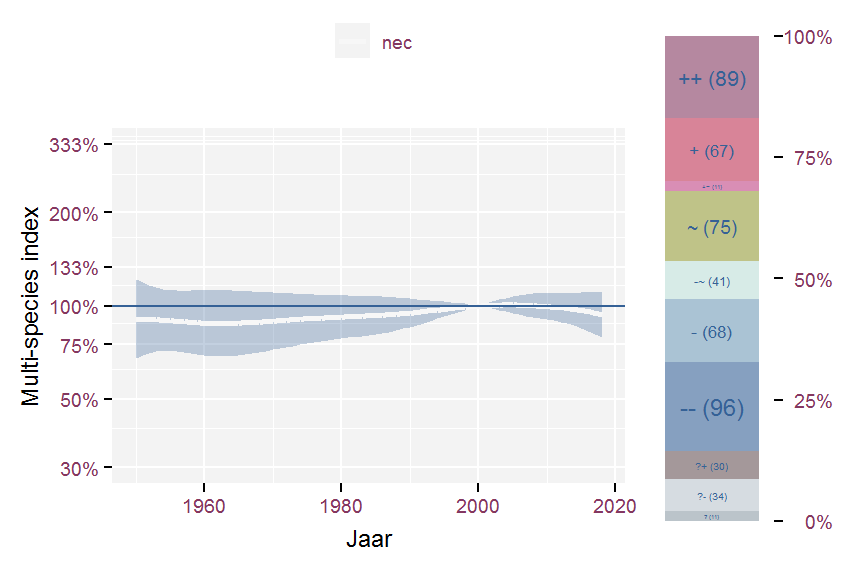
Figure 3.1: Evolution of the flora based on those species for which data between 1950 and 2018 were available. The index uses 2000 as baseline year.
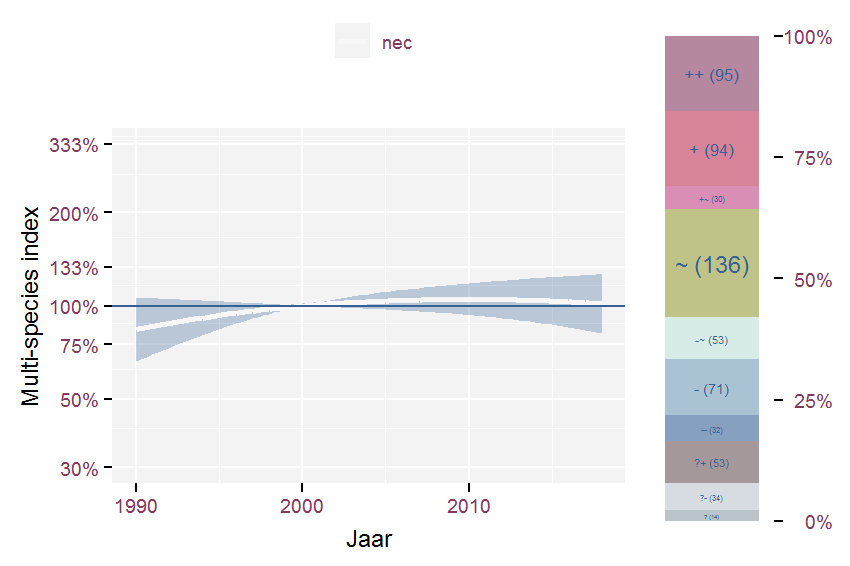
Figure 3.2: Evolution of the flora based on those species for which data between 1990 and 2018 were available. The index uses 2000 as baseline year.
3.2 Broad habitat preference
3.2.1 arable land
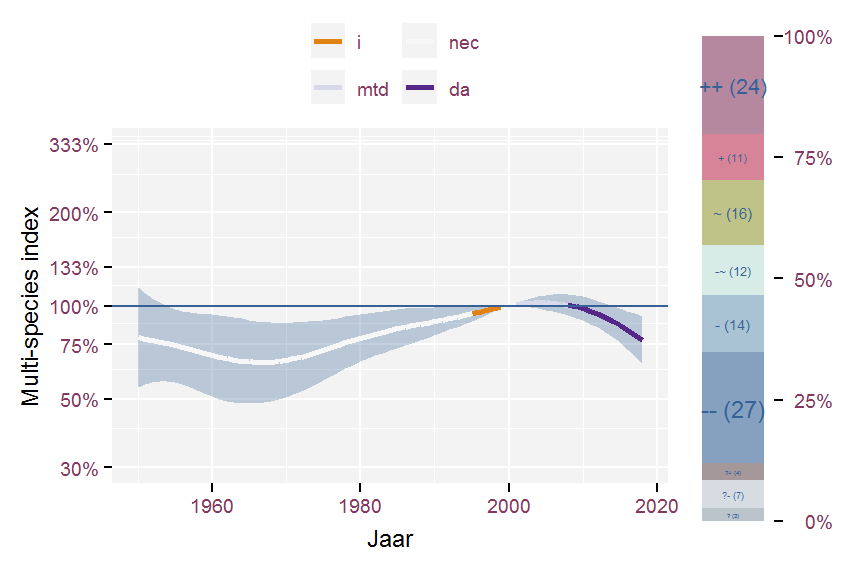
Figure 3.3: Multi-species index for species belonging to broad habitat preference arable land and period 1950-2018. The index uses 2000 as baseline year.
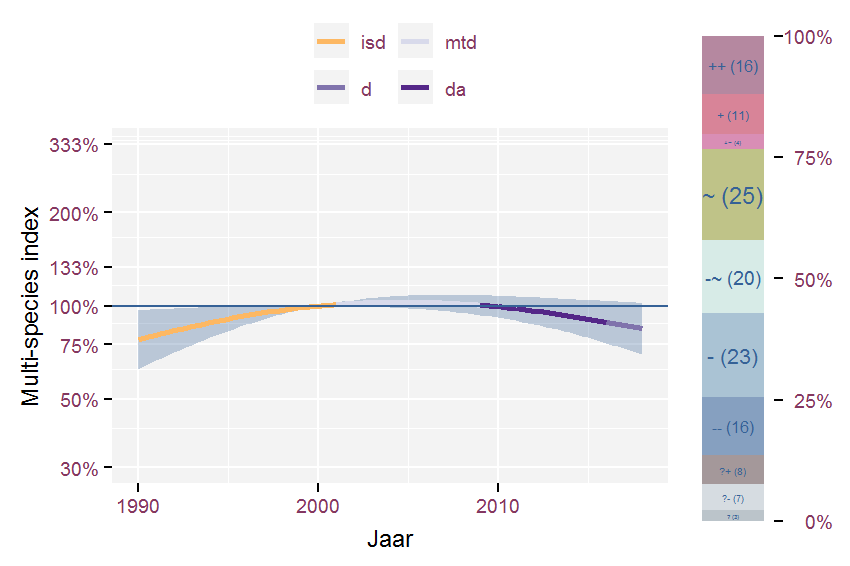
Figure 3.4: Multi-species index for species groups belonging to broad habitat preference arable land and period 1990-2018. The index uses 2000 as baseline year.
3.2.2 coastal dunes
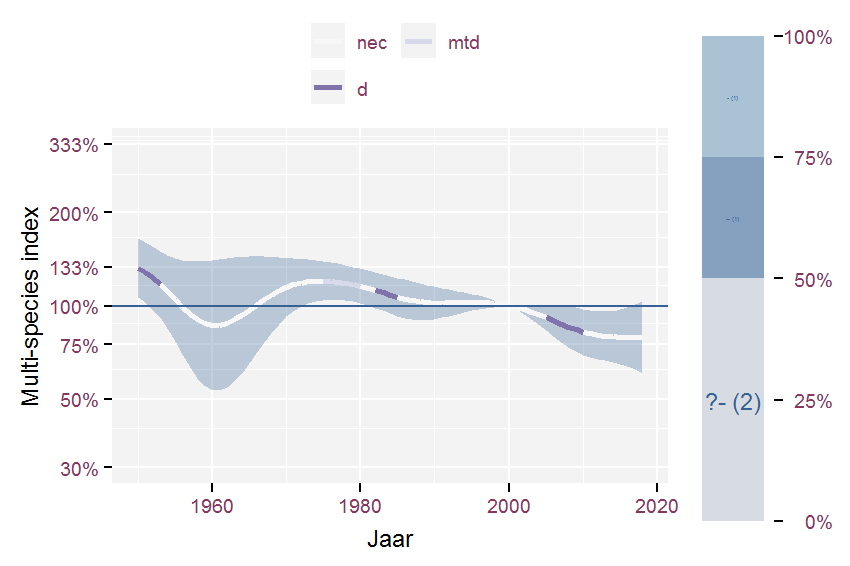
Figure 3.5: Multi-species index for species belonging to broad habitat preference coastal dunes and period 1950-2018. The index uses 2000 as baseline year.
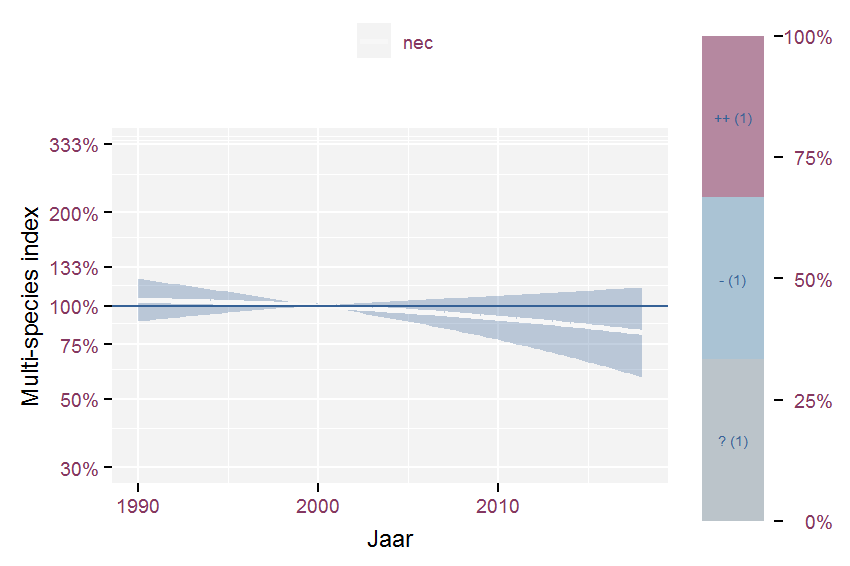
Figure 3.6: Multi-species index for species groups belonging to broad habitat preference coastal dunes and period 1990-2018. The index uses 2000 as baseline year.
3.2.3 forest
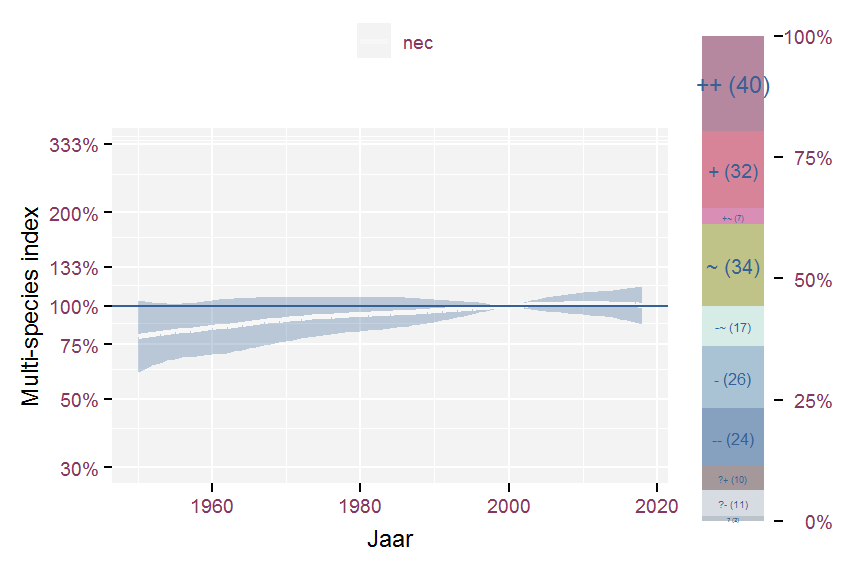
Figure 3.7: Multi-species index for species belonging to broad habitat preference forest and period 1950-2018. The index uses 2000 as baseline year.
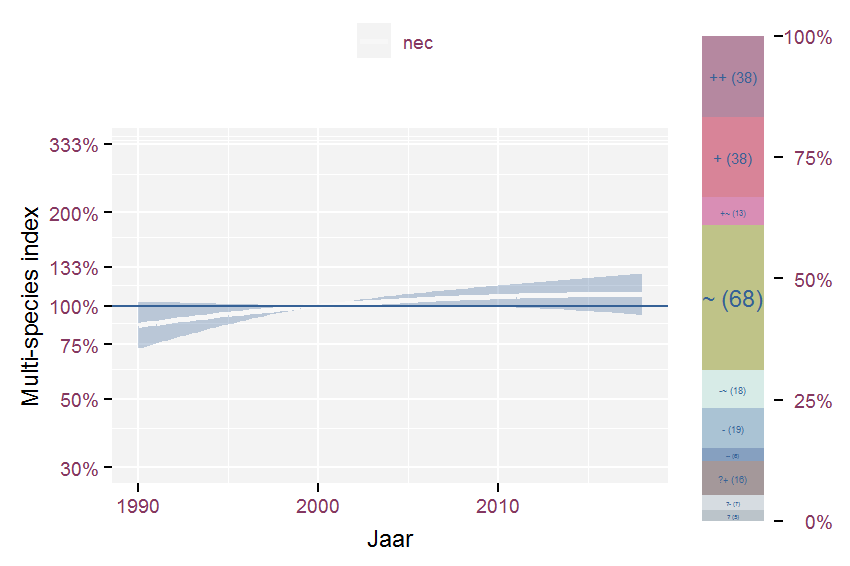
Figure 3.8: Multi-species index for species groups belonging to broad habitat preference forest and period 1990-2018. The index uses 2000 as baseline year.
3.2.4 freshwater habitats
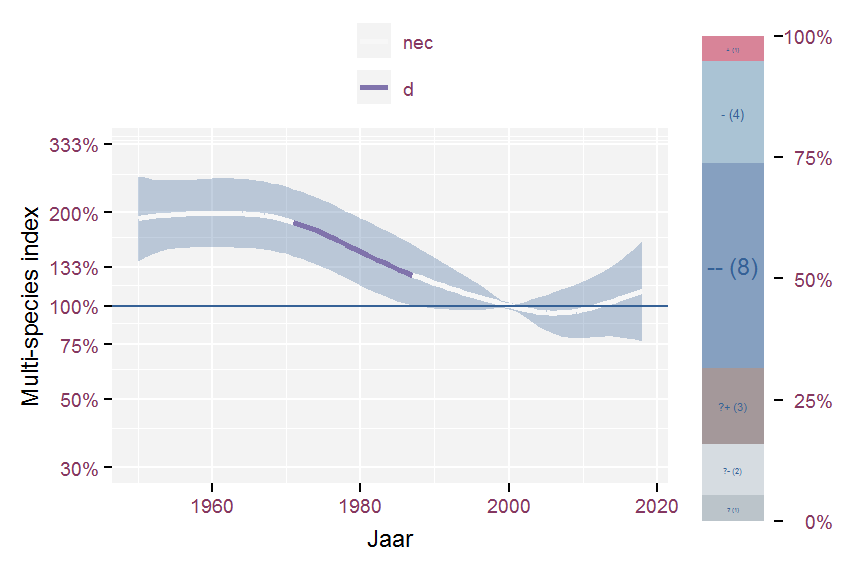
Figure 3.9: Multi-species index for species belonging to broad habitat preference freshwater habitats and period 1950-2018. The index uses 2000 as baseline year.
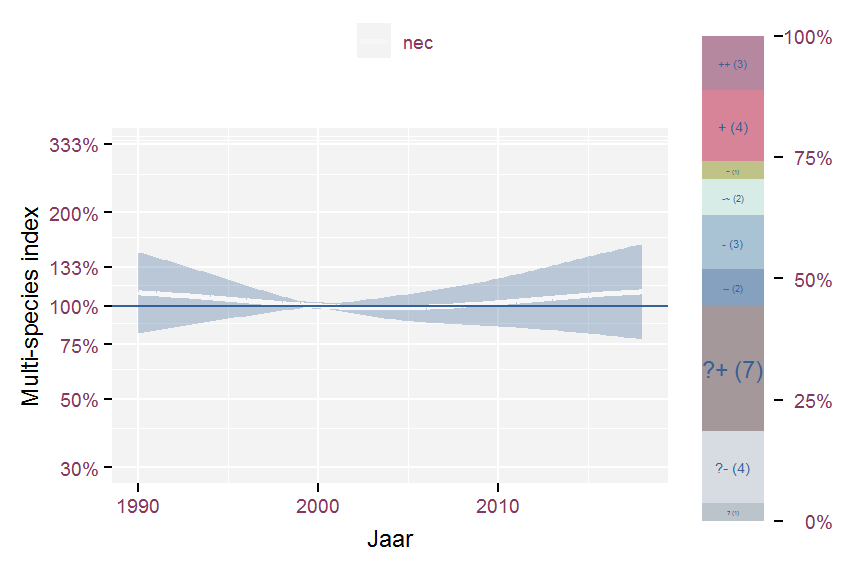
Figure 3.10: Multi-species index for species groups belonging to broad habitat preference freshwater habitats and period 1990-2018. The index uses 2000 as baseline year.
3.2.5 grassland
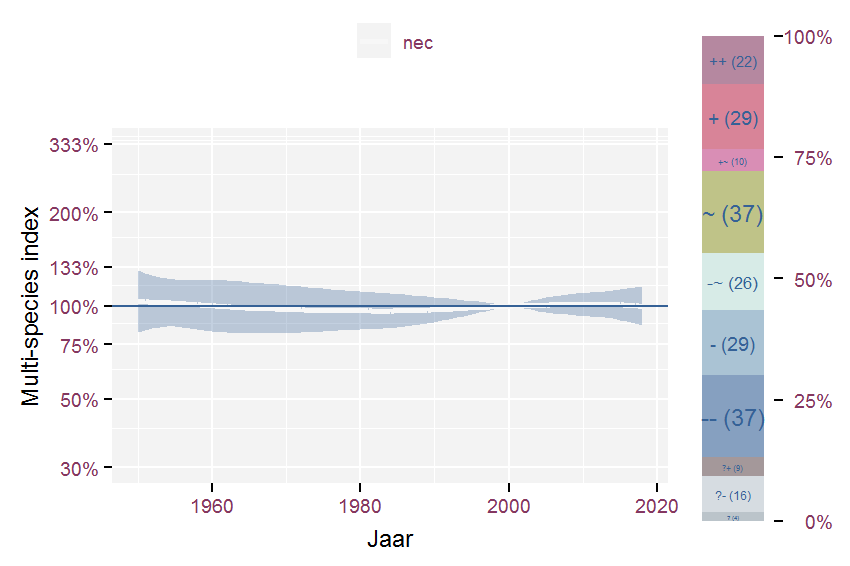
Figure 3.11: Multi-species index for species belonging to broad habitat preference grassland and period 1950-2018. The index uses 2000 as baseline year.
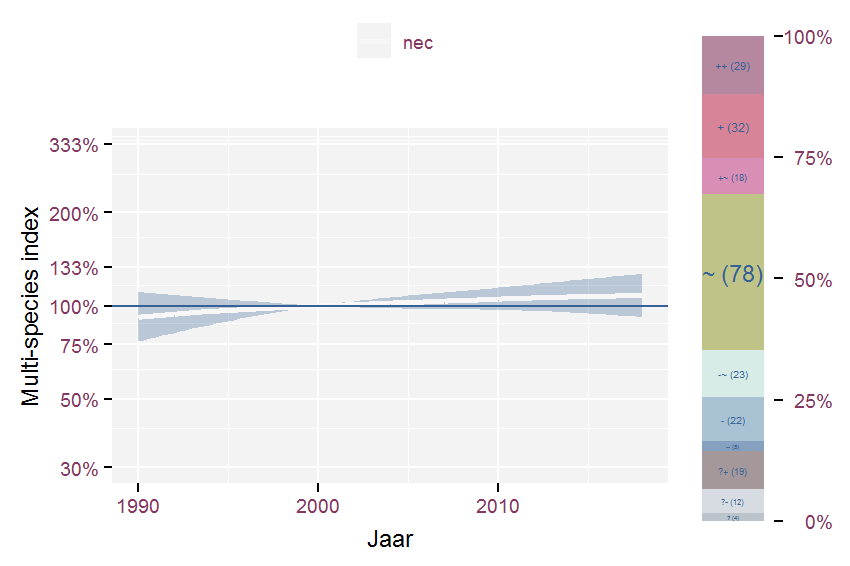
Figure 3.12: Multi-species index for species groups belonging to broad habitat preference grassland and period 1990-2018. The index uses 2000 as baseline year.
3.2.6 heathland
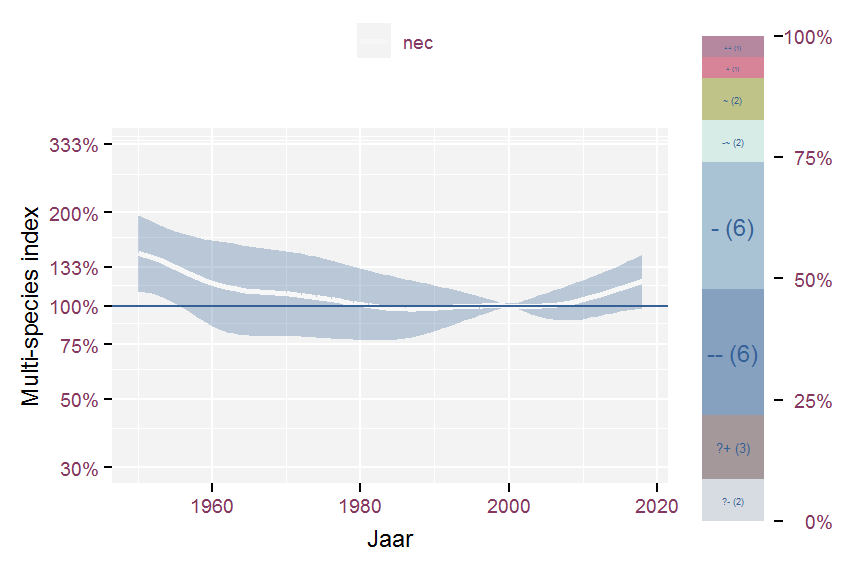
Figure 3.13: Multi-species index for species belonging to broad habitat preference heathland and period 1950-2018. The index uses 2000 as baseline year.
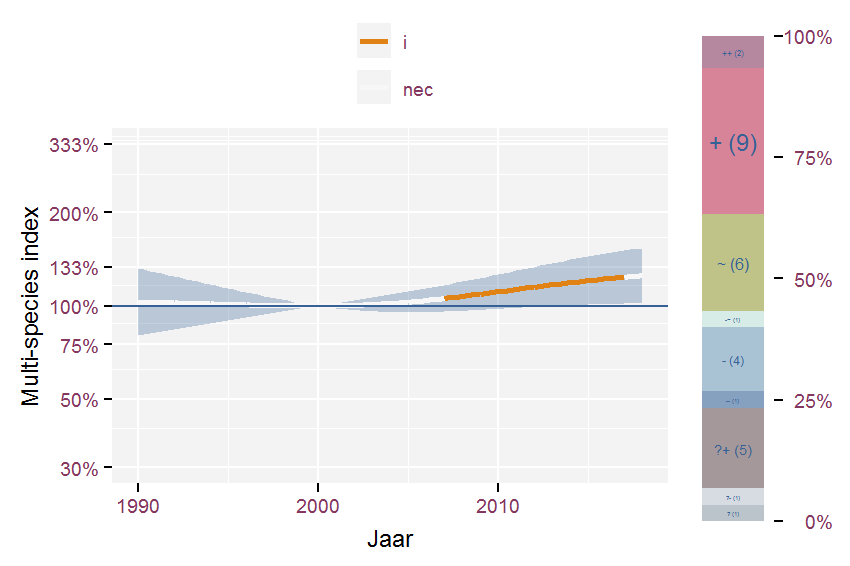
Figure 3.14: Multi-species index for species groups belonging to broad habitat preference heathland and period 1990-2018. The index uses 2000 as baseline year.
3.2.7 marshes
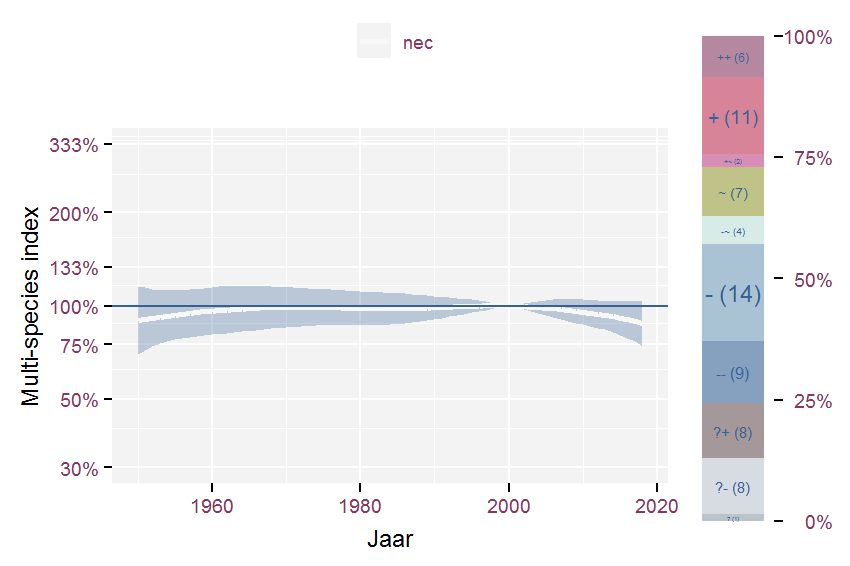
Figure 3.15: Multi-species index for species belonging to broad habitat preference marshes and period 1950-2018. The index uses 2000 as baseline year.

Figure 3.16: Multi-species index for species groups belonging to broad habitat preference marshes and period 1990-2018. The index uses 2000 as baseline year.
3.2.8 saline and brackish habitats

Figure 3.17: Multi-species index for species belonging to broad habitat preference saline and brackish habitats and period 1950-2018. The index uses 2000 as baseline year.

Figure 3.18: Multi-species index for species groups belonging to broad habitat preference saline and brackish habitats and period 1990-2018. The index uses 2000 as baseline year.
3.2.9 urban
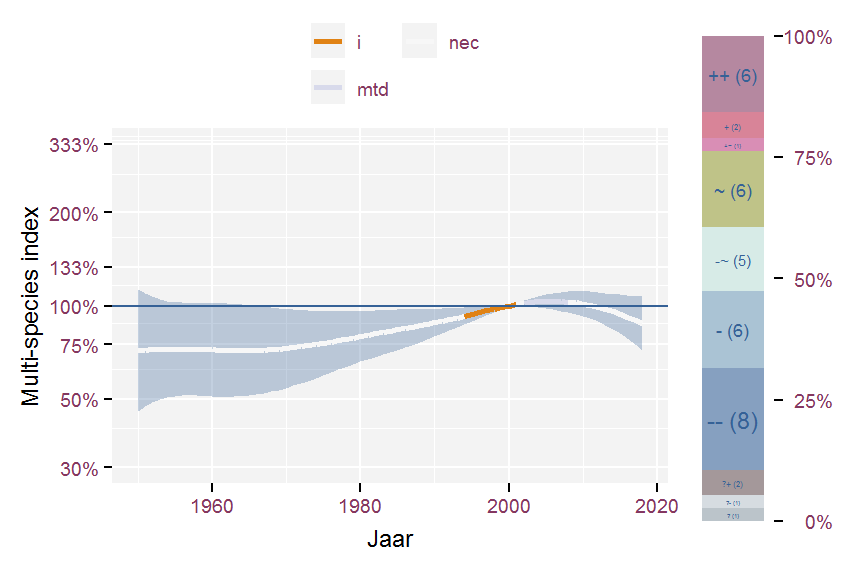
Figure 3.19: Multi-species index for species belonging to broad habitat preference urban and period 1950-2018. The index uses 2000 as baseline year.
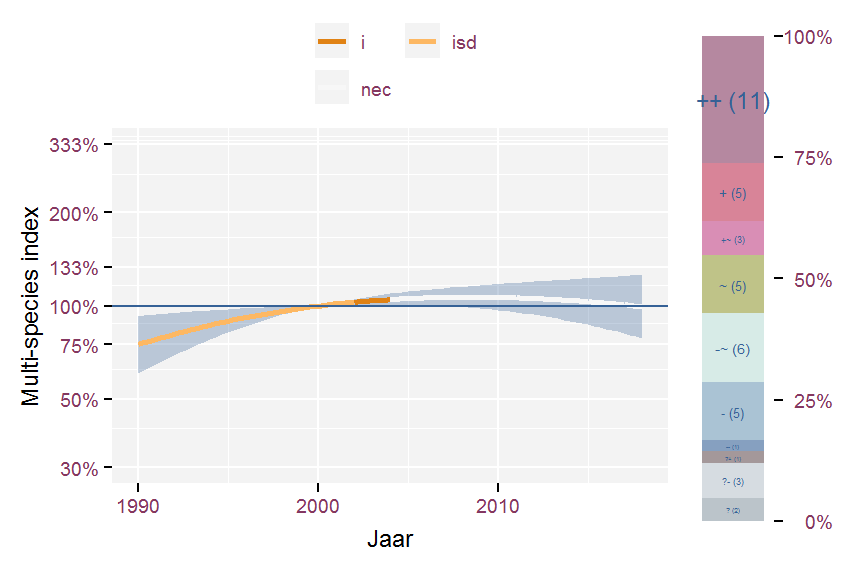
Figure 3.20: Multi-species index for species groups belonging to broad habitat preference urban and period 1990-2018. The index uses 2000 as baseline year.
3.3 Socio-ecological groups (Stieperaere and Fransen 1982)
3.3.1 alluvial forests
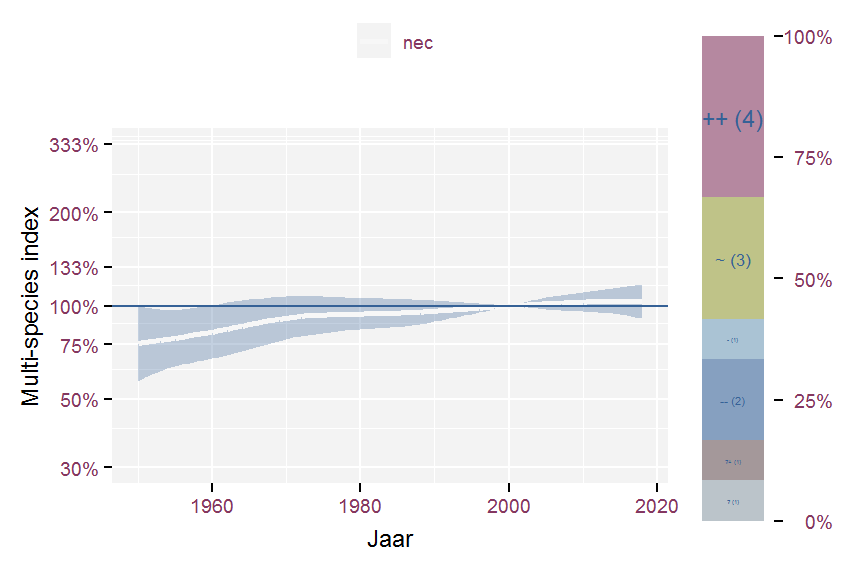
Figure 3.21: Multi-species index for species belonging to Socio-ecological groups (Stieperaere & Franssen 1982) alluvial forests and period 1950-2018. The index uses 2000 as baseline year.
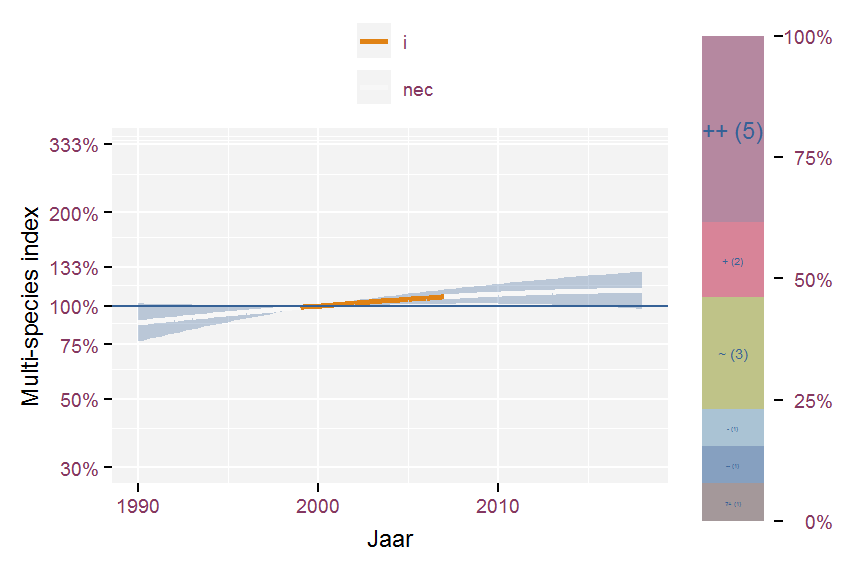
Figure 3.22: Multi-species index for species groups belonging to Socio-ecological groups (Stieperaere & Franssen 1982) alluvial forests and period 1990-2018. The index uses 2000 as baseline year.
3.3.2 arable land on nutrient poor acidic soils
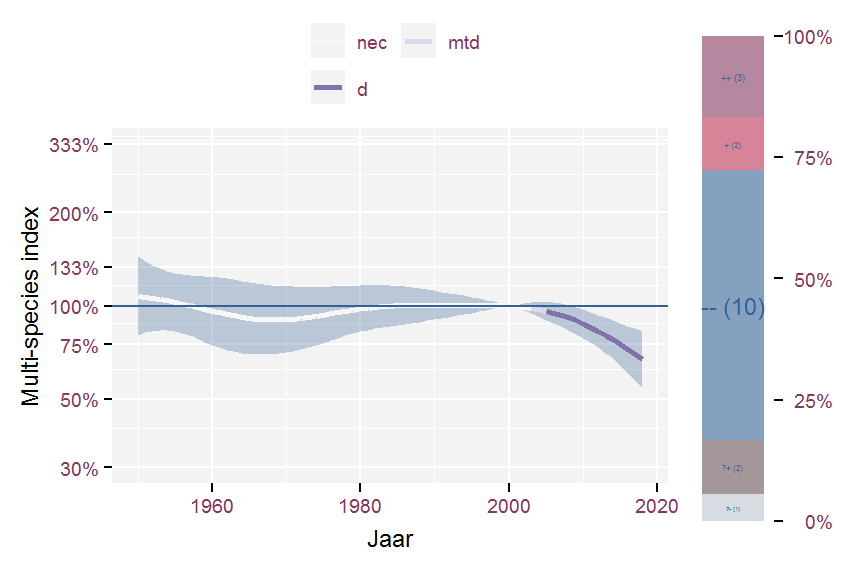
Figure 3.23: Multi-species index for species belonging to Socio-ecological groups (Stieperaere & Franssen 1982) arable land on nutrient poor acidic soils and period 1950-2018. The index uses 2000 as baseline year.
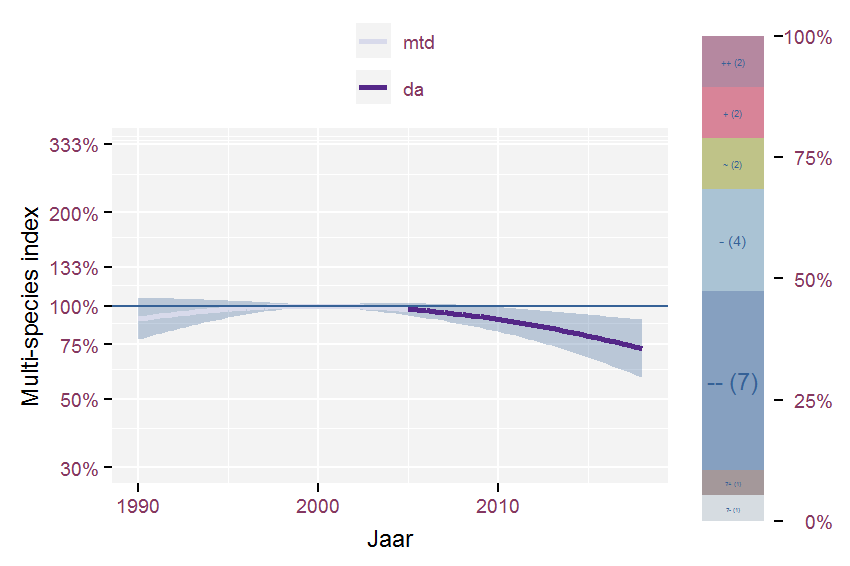
Figure 3.24: Multi-species index for species groups belonging to Socio-ecological groups (Stieperaere & Franssen 1982) arable land on nutrient poor acidic soils and period 1990-2018. The index uses 2000 as baseline year.
3.3.3 arable land on nutrient rich soils but not rich in calcium
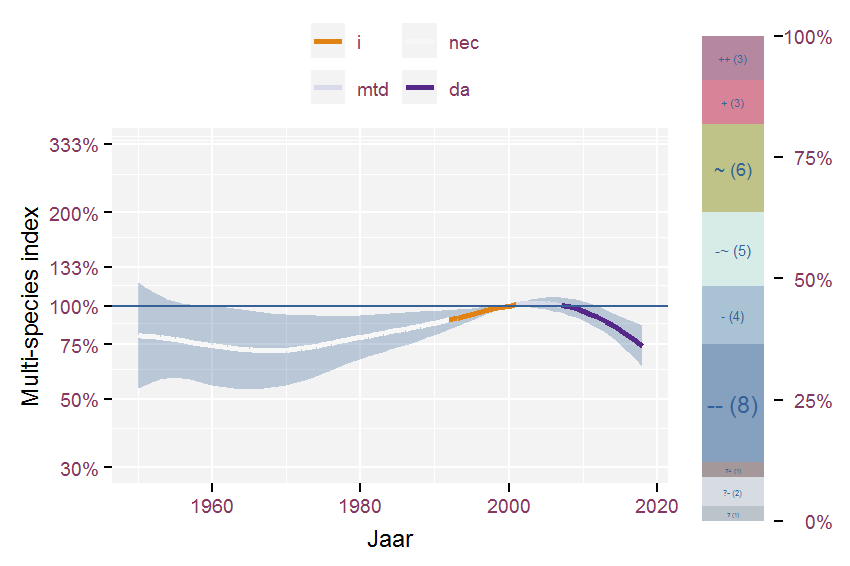
Figure 3.25: Multi-species index for species belonging to Socio-ecological groups (Stieperaere & Franssen 1982) arable land on nutrient rich soils but not rich in calcium and period 1950-2018. The index uses 2000 as baseline year.
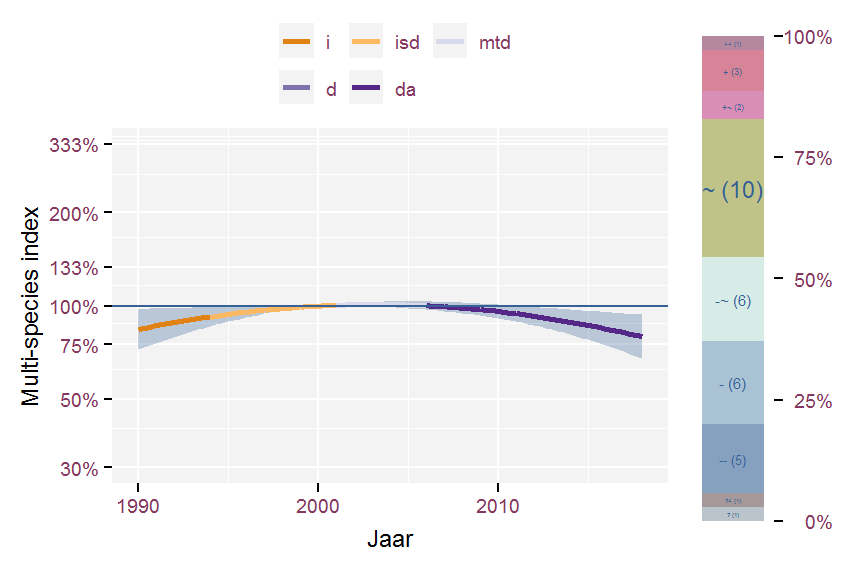
Figure 3.26: Multi-species index for species groups belonging to Socio-ecological groups (Stieperaere & Franssen 1982) arable land on nutrient rich soils but not rich in calcium and period 1990-2018. The index uses 2000 as baseline year.
3.3.4 clearcuttings on moderately moist to dry, moderately nutrient-rich to nutrient-rich soil
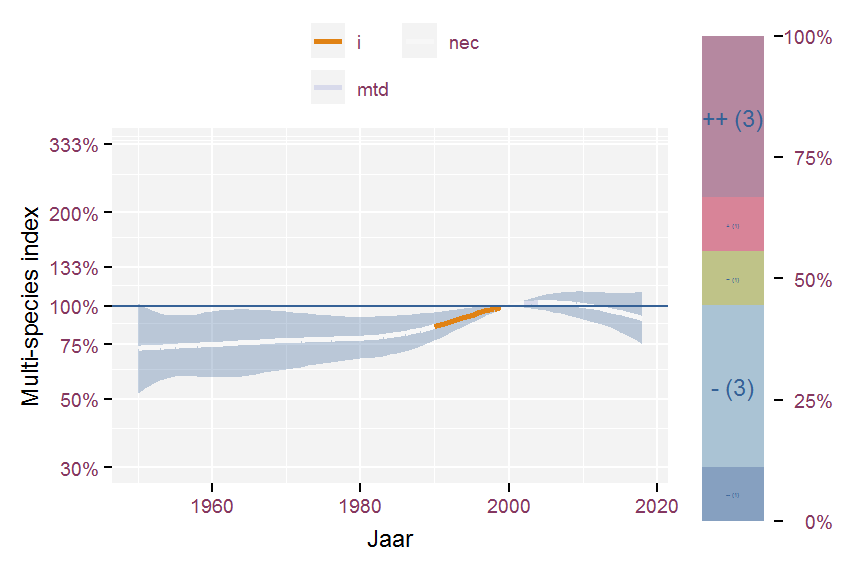
Figure 3.27: Multi-species index for species belonging to Socio-ecological groups (Stieperaere & Franssen 1982) clearcuttings on moderately moist to dry, moderately nutrient-rich to nutrient-rich soil and period 1950-2018. The index uses 2000 as baseline year.
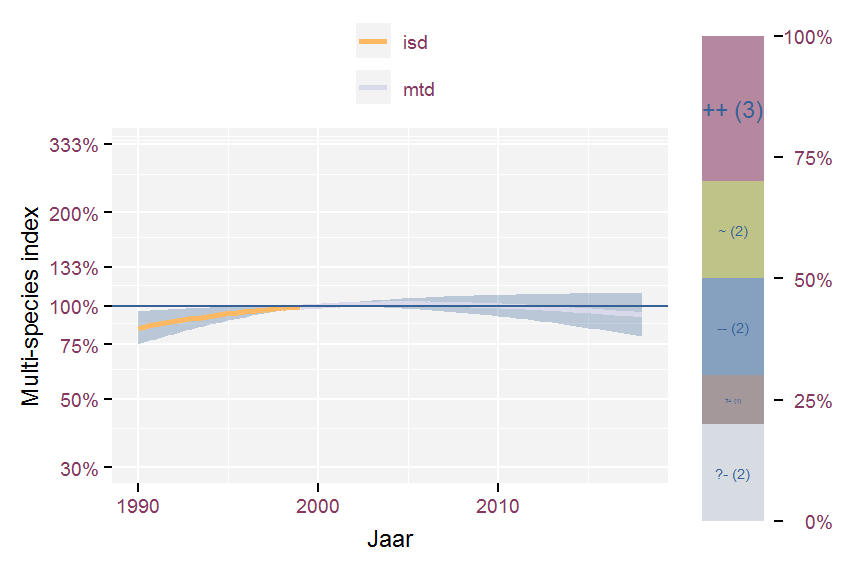
Figure 3.28: Multi-species index for species groups belonging to Socio-ecological groups (Stieperaere & Franssen 1982) clearcuttings on moderately moist to dry, moderately nutrient-rich to nutrient-rich soil and period 1990-2018. The index uses 2000 as baseline year.
3.3.5 drift lines, rough herbaceous vegetation on shores and willow shrub along rivers
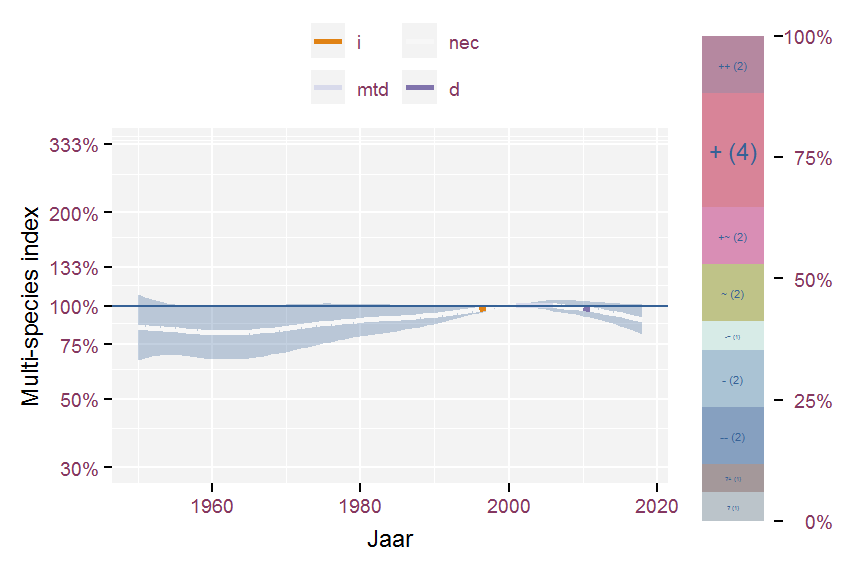
Figure 3.29: Multi-species index for species belonging to Socio-ecological groups (Stieperaere & Franssen 1982) drift lines, rough herbaceous vegetation on shores and willow shrub along rivers and period 1950-2018. The index uses 2000 as baseline year.
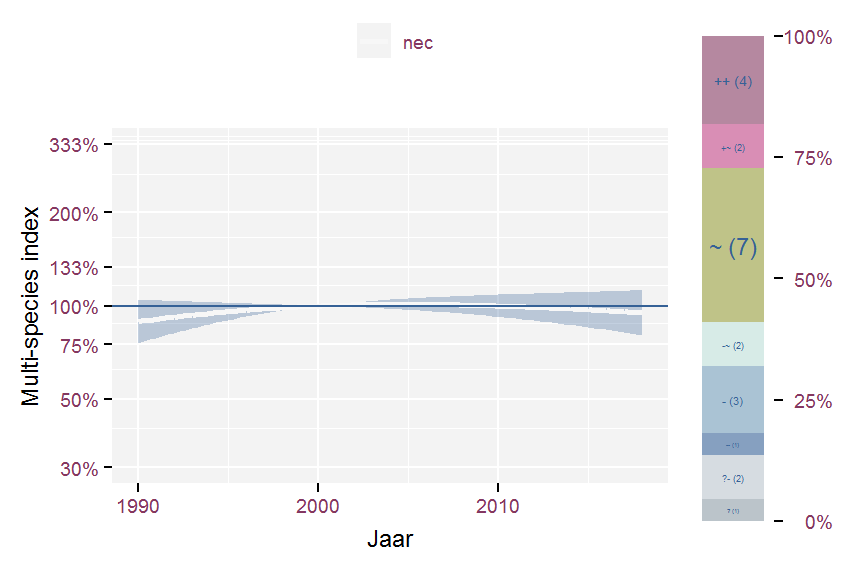
Figure 3.30: Multi-species index for species groups belonging to Socio-ecological groups (Stieperaere & Franssen 1982) drift lines, rough herbaceous vegetation on shores and willow shrub along rivers and period 1990-2018. The index uses 2000 as baseline year.
3.3.6 dry heathland on nutrient poor soils
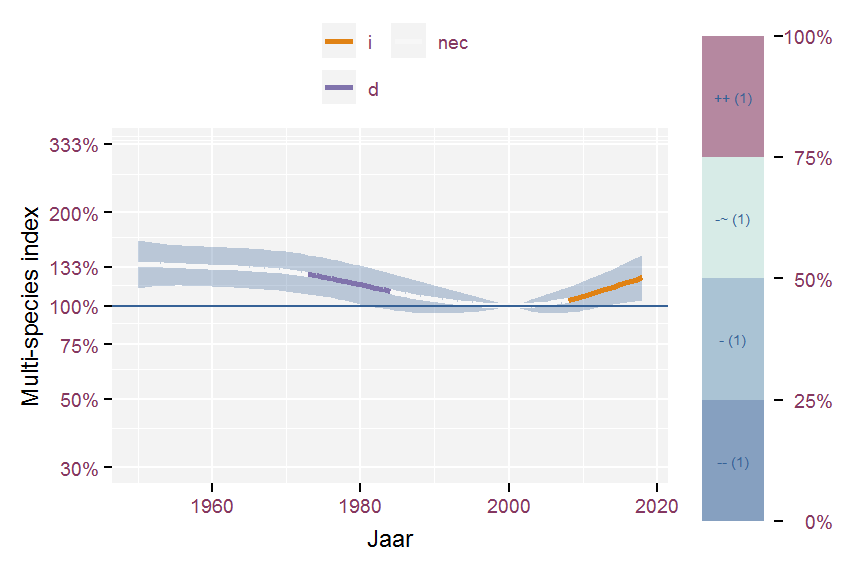
Figure 3.31: Multi-species index for species belonging to Socio-ecological groups (Stieperaere & Franssen 1982) dry heathland on nutrient poor soils and period 1950-2018. The index uses 2000 as baseline year.
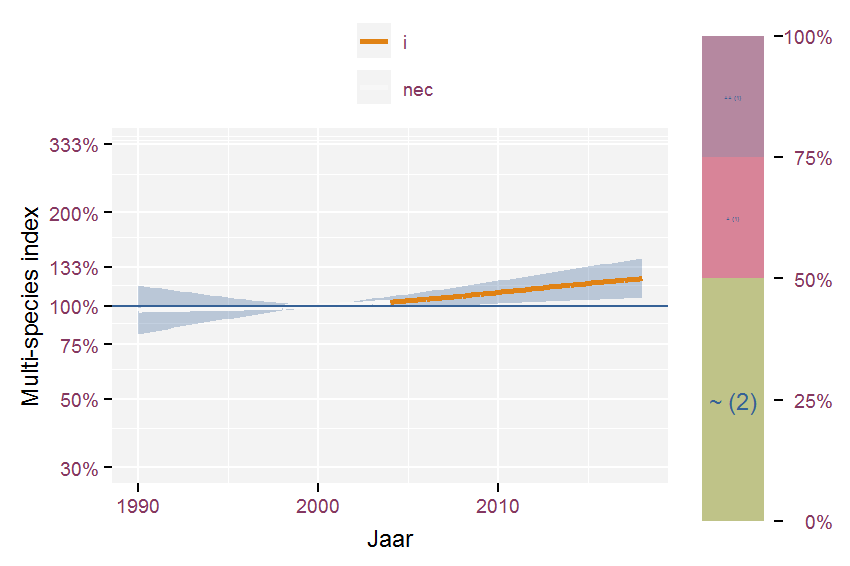
Figure 3.32: Multi-species index for species groups belonging to Socio-ecological groups (Stieperaere & Franssen 1982) dry heathland on nutrient poor soils and period 1990-2018. The index uses 2000 as baseline year.
3.3.7 forests on moderate nutrient poor, dry acid soils
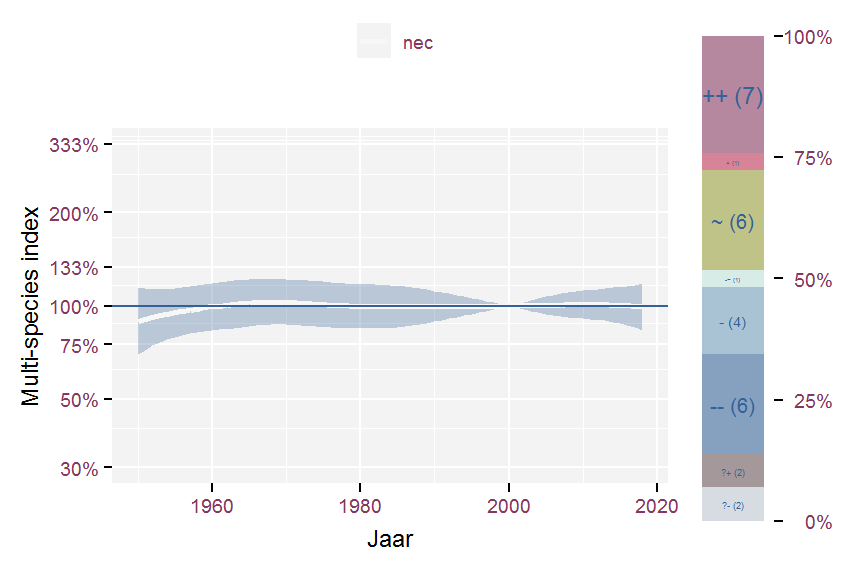
Figure 3.33: Multi-species index for species belonging to Socio-ecological groups (Stieperaere & Franssen 1982) forests on moderate nutrient poor, dry acid soils and period 1950-2018. The index uses 2000 as baseline year.

Figure 3.34: Multi-species index for species groups belonging to Socio-ecological groups (Stieperaere & Franssen 1982) forests on moderate nutrient poor, dry acid soils and period 1990-2018. The index uses 2000 as baseline year.
3.3.8 forests on moderate nutrient rich, moist to wet soils and headwaters
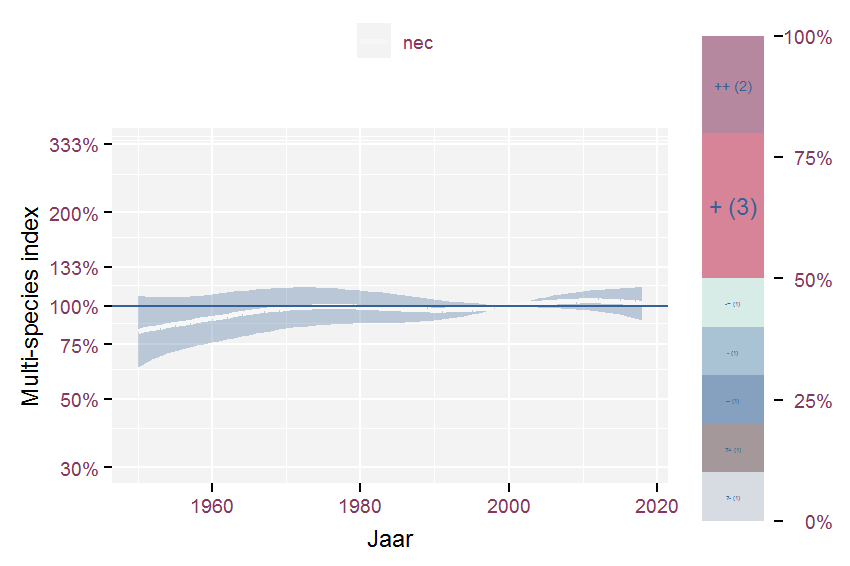
Figure 3.35: Multi-species index for species belonging to Socio-ecological groups (Stieperaere & Franssen 1982) forests on moderate nutrient rich, moist to wet soils and headwaters and period 1950-2018. The index uses 2000 as baseline year.
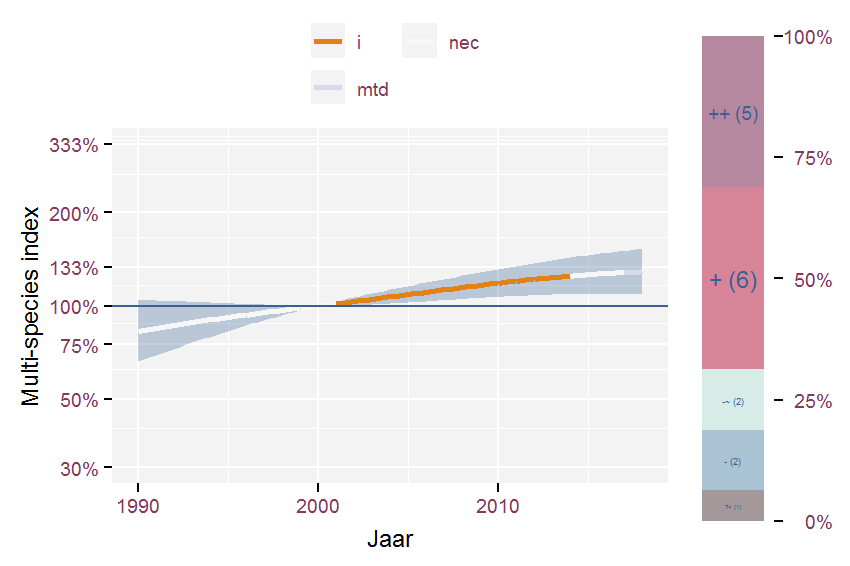
Figure 3.36: Multi-species index for species groups belonging to Socio-ecological groups (Stieperaere & Franssen 1982) forests on moderate nutrient rich, moist to wet soils and headwaters and period 1990-2018. The index uses 2000 as baseline year.
3.3.9 forests on moist soils, moderate rich in nutrients
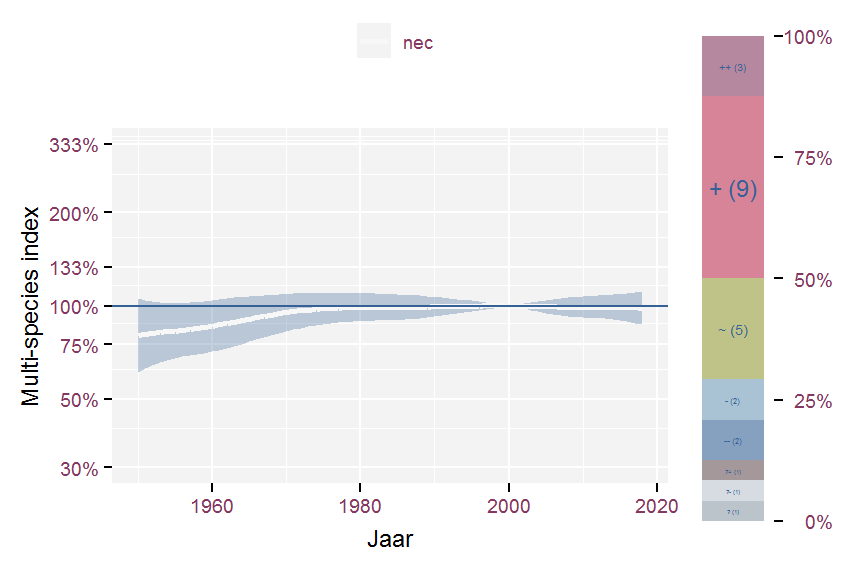
Figure 3.37: Multi-species index for species belonging to Socio-ecological groups (Stieperaere & Franssen 1982) forests on moist soils, moderate rich in nutrients and period 1950-2018. The index uses 2000 as baseline year.
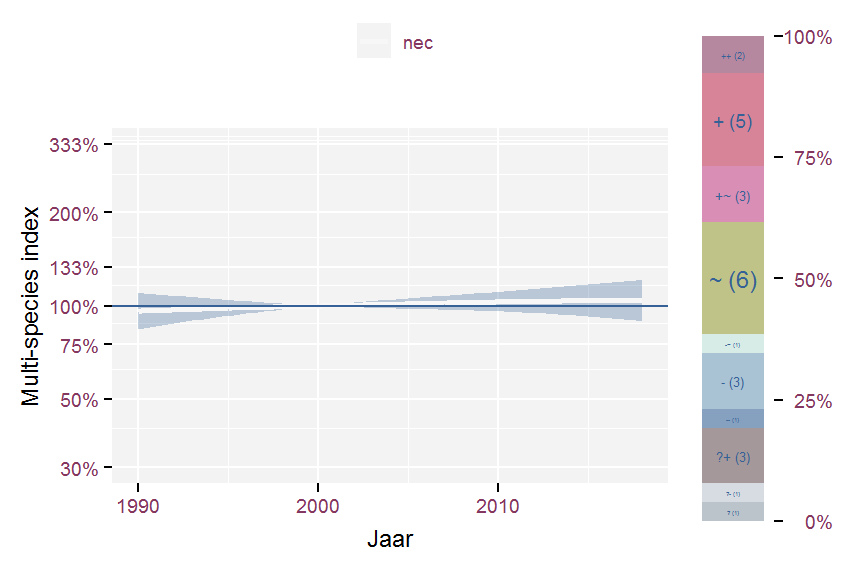
Figure 3.38: Multi-species index for species groups belonging to Socio-ecological groups (Stieperaere & Franssen 1982) forests on moist soils, moderate rich in nutrients and period 1990-2018. The index uses 2000 as baseline year.
3.3.10 forests on old, weakly acidic, neutral to slightly basic soils
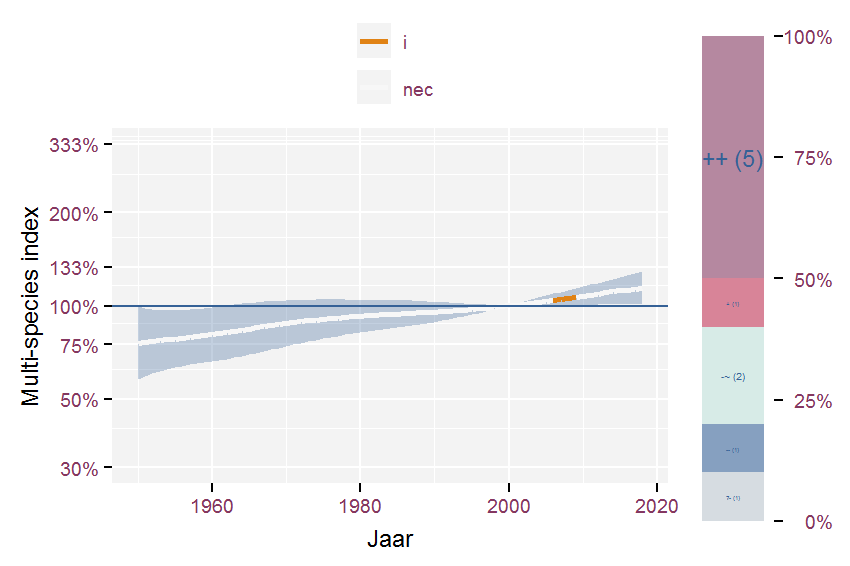
Figure 3.39: Multi-species index for species belonging to Socio-ecological groups (Stieperaere & Franssen 1982) forests on old, weakly acidic, neutral to slightly basic soils and period 1950-2018. The index uses 2000 as baseline year.
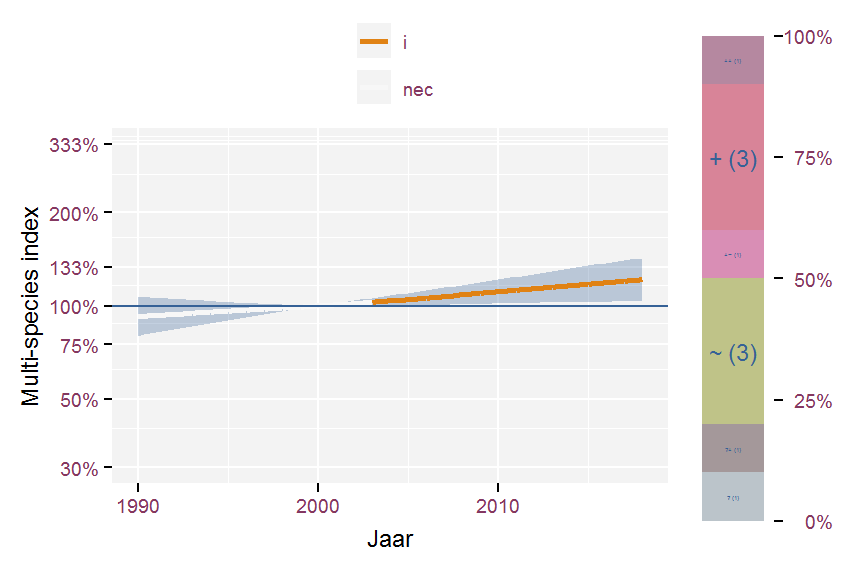
Figure 3.40: Multi-species index for species groups belonging to Socio-ecological groups (Stieperaere & Franssen 1982) forests on old, weakly acidic, neutral to slightly basic soils and period 1990-2018. The index uses 2000 as baseline year.
3.3.11 forests on young, unstable moist and stony soils (ravines)
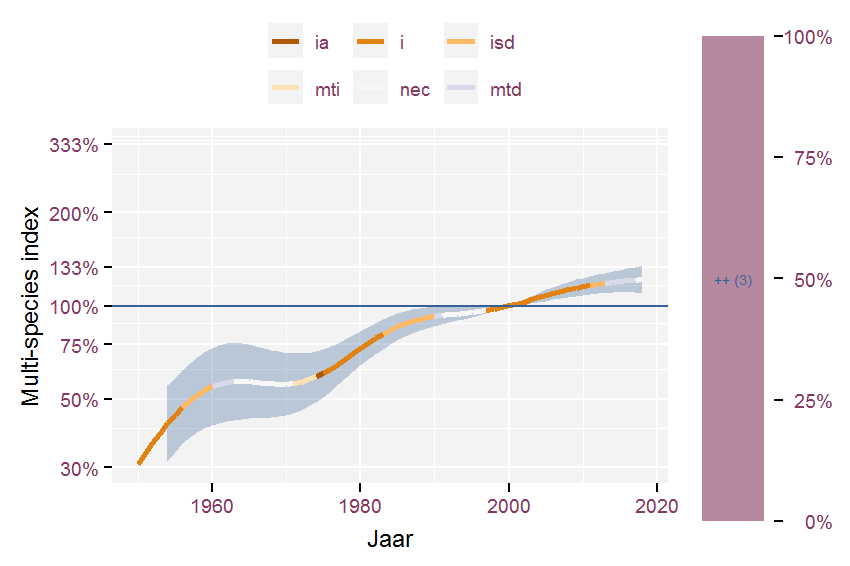
Figure 3.41: Multi-species index for species belonging to Socio-ecological groups (Stieperaere & Franssen 1982) forests on young, unstable moist and stony soils (ravines) and period 1950-2018. The index uses 2000 as baseline year.
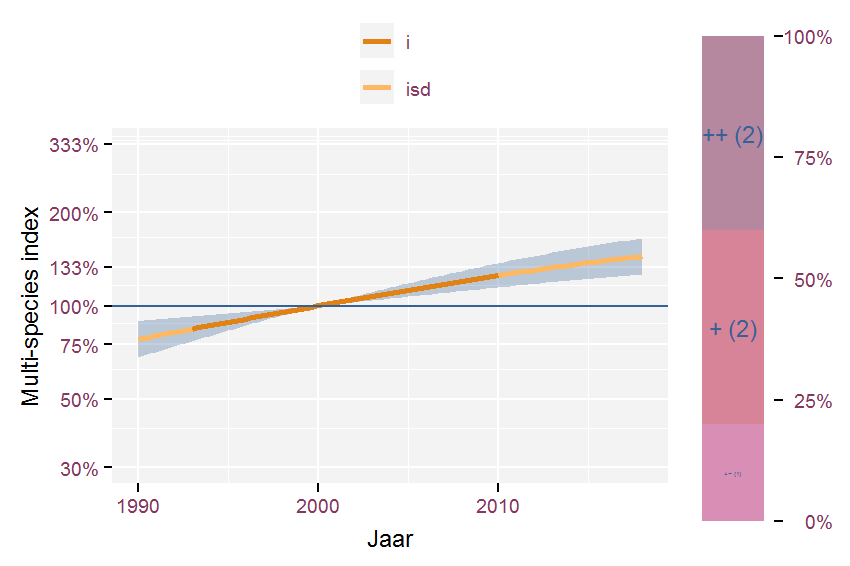
Figure 3.42: Multi-species index for species groups belonging to Socio-ecological groups (Stieperaere & Franssen 1982) forests on young, unstable moist and stony soils (ravines) and period 1990-2018. The index uses 2000 as baseline year.
3.3.12 fresh to weakly brackish, (weakly) nutrient rich waters (mostly obligate aquatic plants)
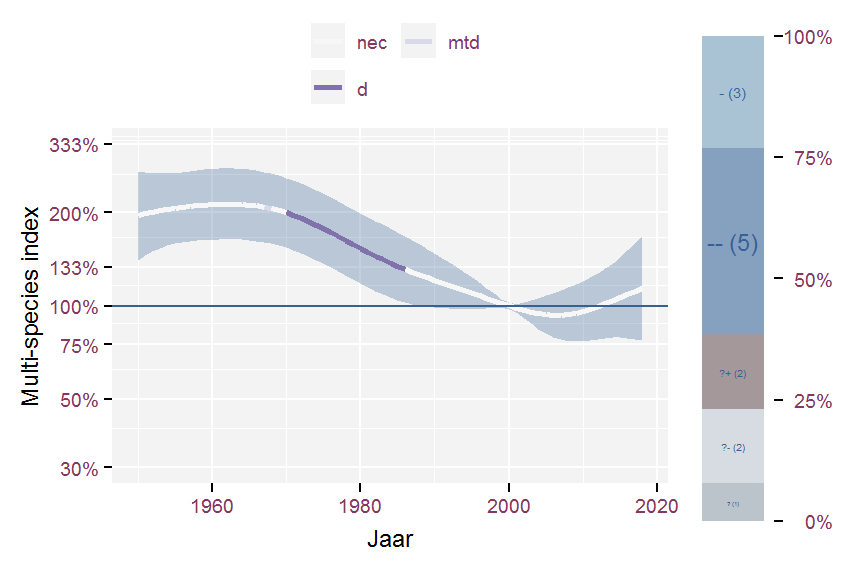
Figure 3.43: Multi-species index for species belonging to Socio-ecological groups (Stieperaere & Franssen 1982) fresh to weakly brackish, (weakly) nutrient rich waters (mostly obligate aquatic plants) and period 1950-2018. The index uses 2000 as baseline year.
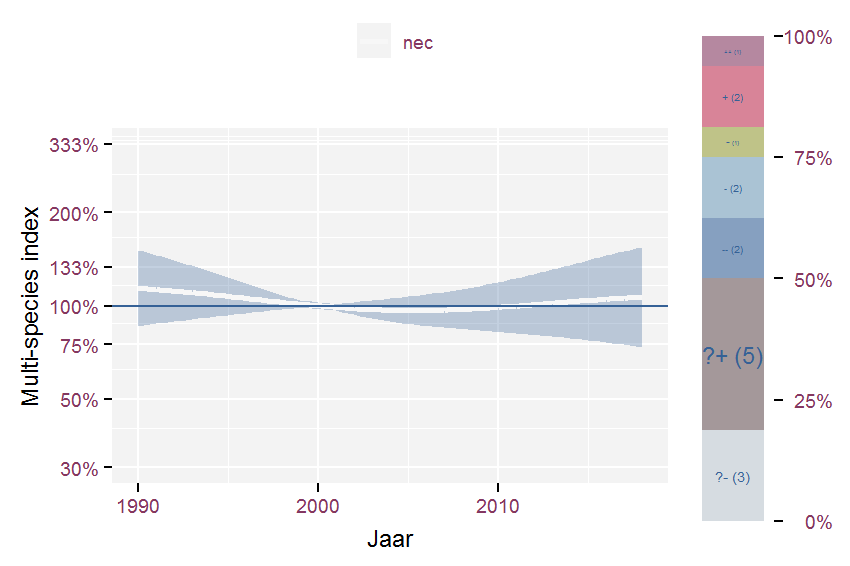
Figure 3.44: Multi-species index for species groups belonging to Socio-ecological groups (Stieperaere & Franssen 1982) fresh to weakly brackish, (weakly) nutrient rich waters (mostly obligate aquatic plants) and period 1990-2018. The index uses 2000 as baseline year.
3.3.13 grasslands on dry, acidic, nutrient poor soils
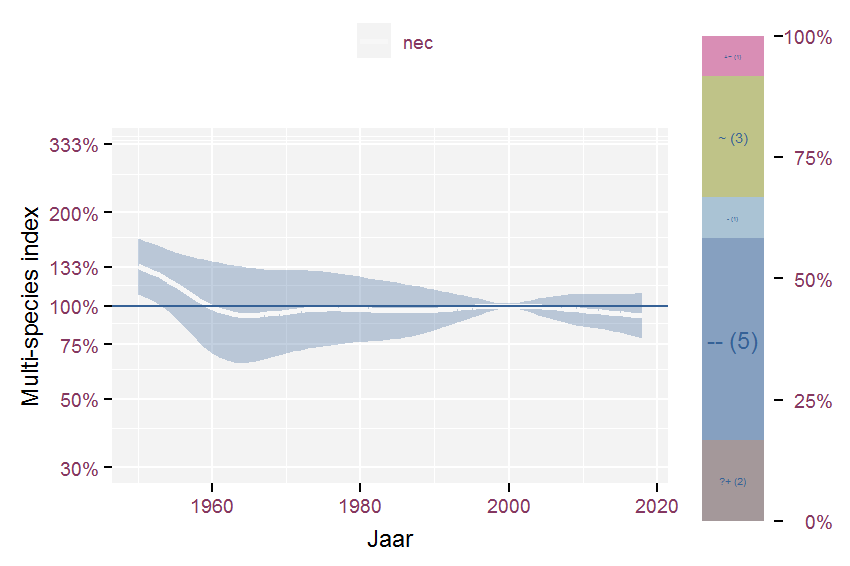
Figure 3.45: Multi-species index for species belonging to Socio-ecological groups (Stieperaere & Franssen 1982) grasslands on dry, acidic, nutrient poor soils and period 1950-2018. The index uses 2000 as baseline year.
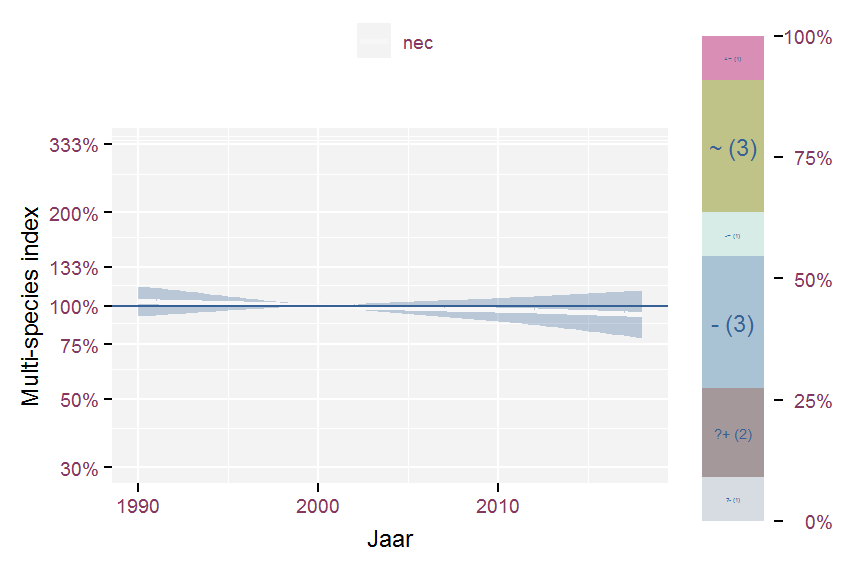
Figure 3.46: Multi-species index for species groups belonging to Socio-ecological groups (Stieperaere & Franssen 1982) grasslands on dry, acidic, nutrient poor soils and period 1990-2018. The index uses 2000 as baseline year.
3.3.14 grasslands on dry, neutral soils, moderate rich in nutrients
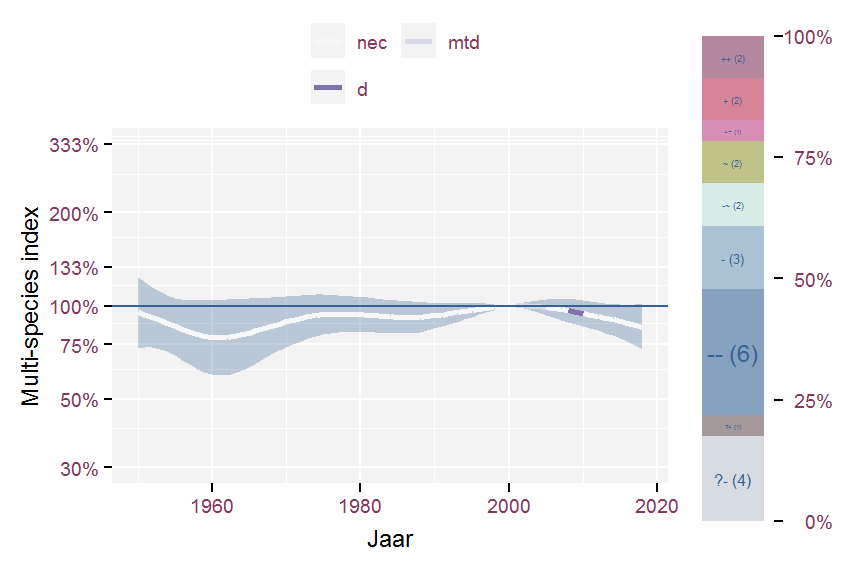
Figure 3.47: Multi-species index for species belonging to Socio-ecological groups (Stieperaere & Franssen 1982) grasslands on dry, neutral soils, moderate rich in nutrients and period 1950-2018. The index uses 2000 as baseline year.
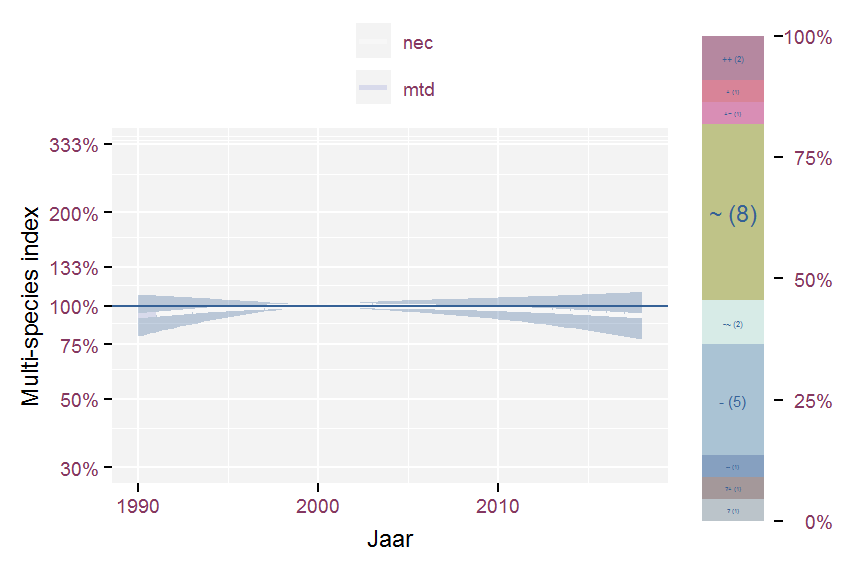
Figure 3.48: Multi-species index for species groups belonging to Socio-ecological groups (Stieperaere & Franssen 1982) grasslands on dry, neutral soils, moderate rich in nutrients and period 1990-2018. The index uses 2000 as baseline year.
3.3.15 grasslands on dry, nutrient poor, calcareous soils or neutral tot basic soils
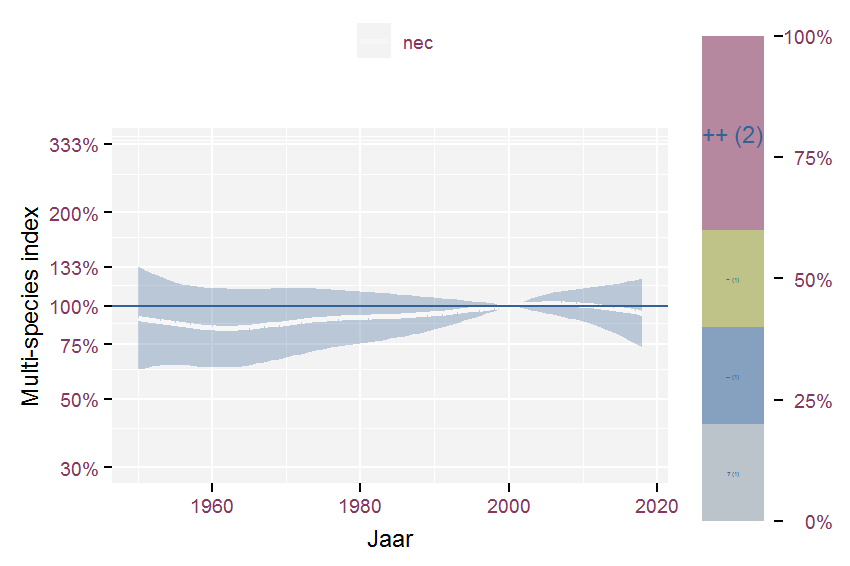
Figure 3.49: Multi-species index for species belonging to Socio-ecological groups (Stieperaere & Franssen 1982) grasslands on dry, nutrient poor, calcareous soils or neutral tot basic soils and period 1950-2018. The index uses 2000 as baseline year.
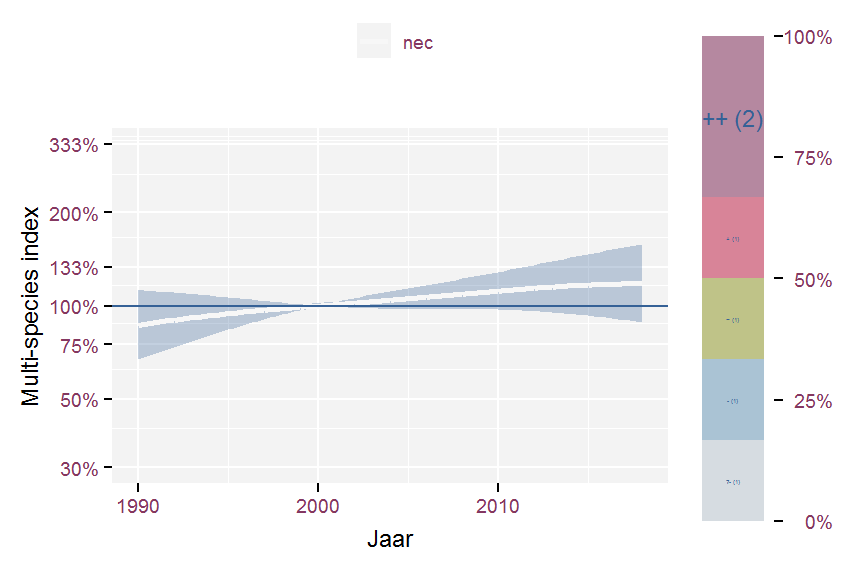
Figure 3.50: Multi-species index for species groups belonging to Socio-ecological groups (Stieperaere & Franssen 1982) grasslands on dry, nutrient poor, calcareous soils or neutral tot basic soils and period 1990-2018. The index uses 2000 as baseline year.
3.3.16 marsh vegetation in fresh, nutrient-rich, flowing or periodically dry waters; not peat forming
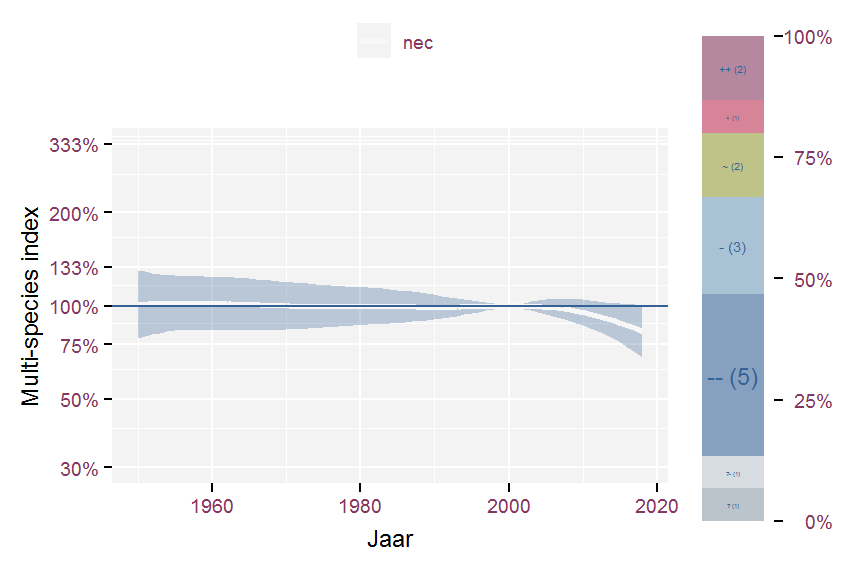
Figure 3.51: Multi-species index for species belonging to Socio-ecological groups (Stieperaere & Franssen 1982) marsh vegetation in fresh, nutrient-rich, flowing or periodically dry waters; not peat forming and period 1950-2018. The index uses 2000 as baseline year.

Figure 3.52: Multi-species index for species groups belonging to Socio-ecological groups (Stieperaere & Franssen 1982) marsh vegetation in fresh, nutrient-rich, flowing or periodically dry waters; not peat forming and period 1990-2018. The index uses 2000 as baseline year.
3.3.17 marsh vegetation in fresh, nutrient-rich, stagnant or light-flowing shallow to deep waters; often peat forming
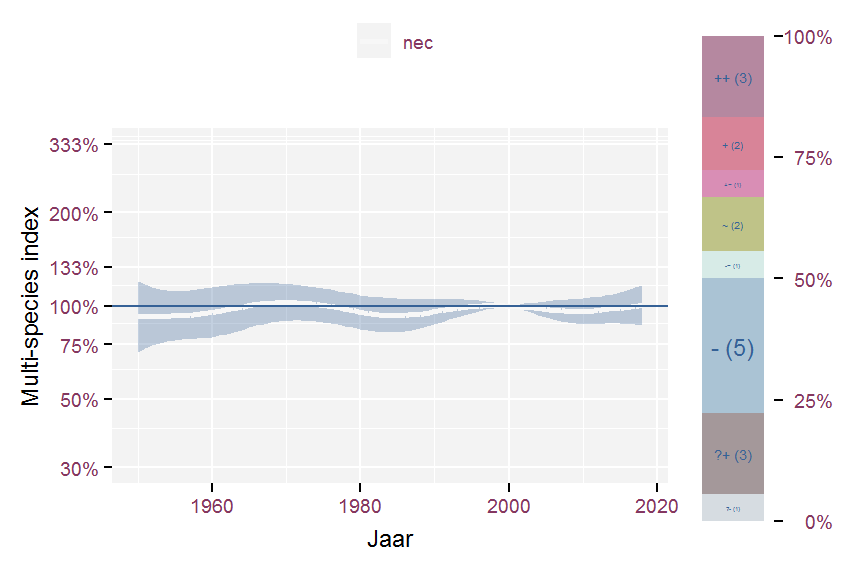
Figure 3.53: Multi-species index for species belonging to Socio-ecological groups (Stieperaere & Franssen 1982) marsh vegetation in fresh, nutrient-rich, stagnant or light-flowing shallow to deep waters; often peat forming and period 1950-2018. The index uses 2000 as baseline year.
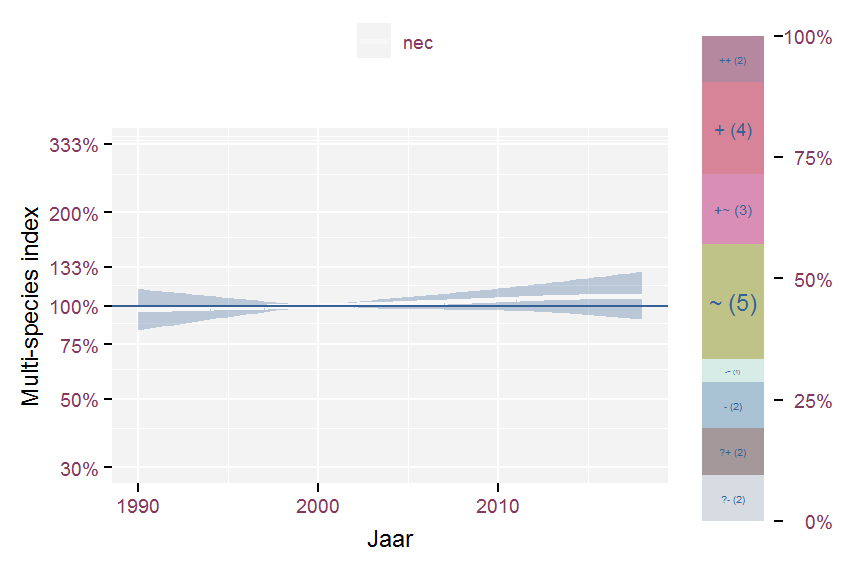
Figure 3.54: Multi-species index for species groups belonging to Socio-ecological groups (Stieperaere & Franssen 1982) marsh vegetation in fresh, nutrient-rich, stagnant or light-flowing shallow to deep waters; often peat forming and period 1990-2018. The index uses 2000 as baseline year.
3.3.18 moderately fertilized grasslands on (moderately) moist soil

Figure 3.55: Multi-species index for species belonging to Socio-ecological groups (Stieperaere & Franssen 1982) moderately fertilized grasslands on (moderately) moist soil and period 1950-2018. The index uses 2000 as baseline year.
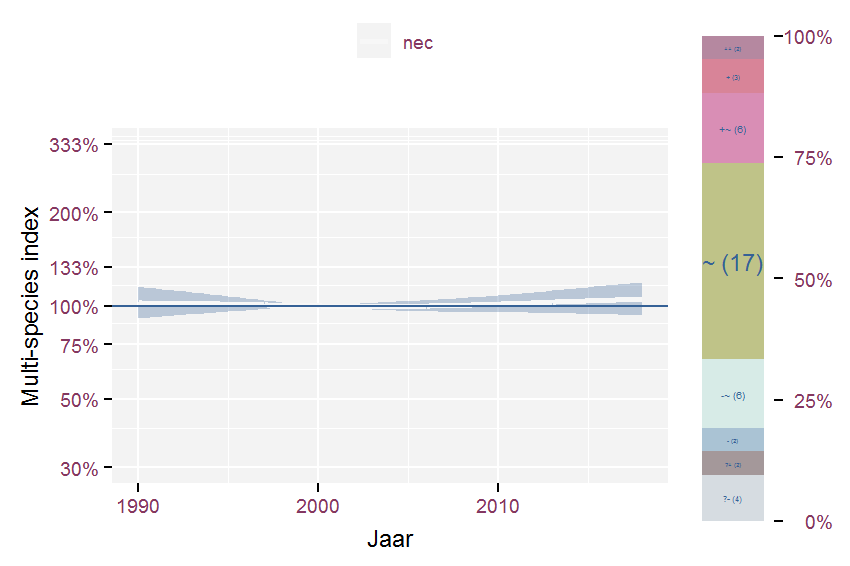
Figure 3.56: Multi-species index for species groups belonging to Socio-ecological groups (Stieperaere & Franssen 1982) moderately fertilized grasslands on (moderately) moist soil and period 1990-2018. The index uses 2000 as baseline year.
3.3.19 moderately fertilized grasslands on wet soil
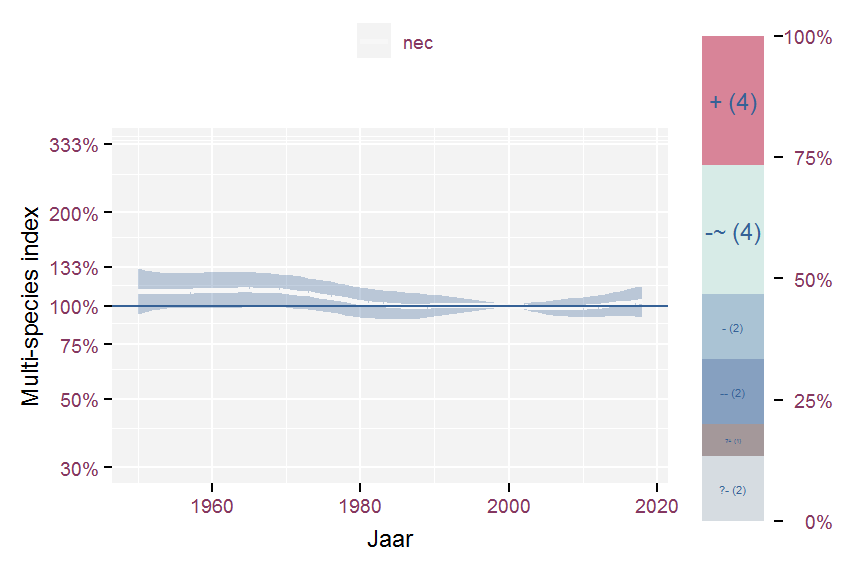
Figure 3.57: Multi-species index for species belonging to Socio-ecological groups (Stieperaere & Franssen 1982) moderately fertilized grasslands on wet soil and period 1950-2018. The index uses 2000 as baseline year.
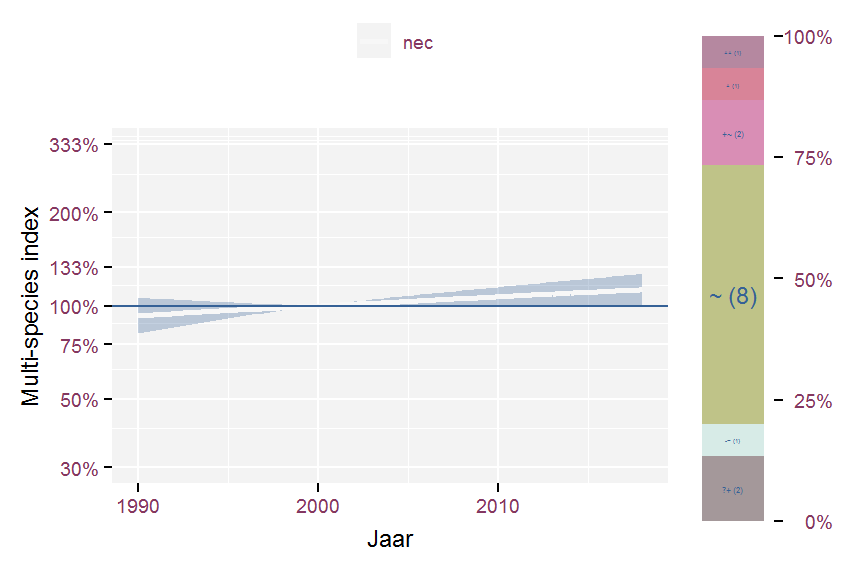
Figure 3.58: Multi-species index for species groups belonging to Socio-ecological groups (Stieperaere & Franssen 1982) moderately fertilized grasslands on wet soil and period 1990-2018. The index uses 2000 as baseline year.
3.3.20 moderately nutrient-poor, lime-poor, acidic peat bogs
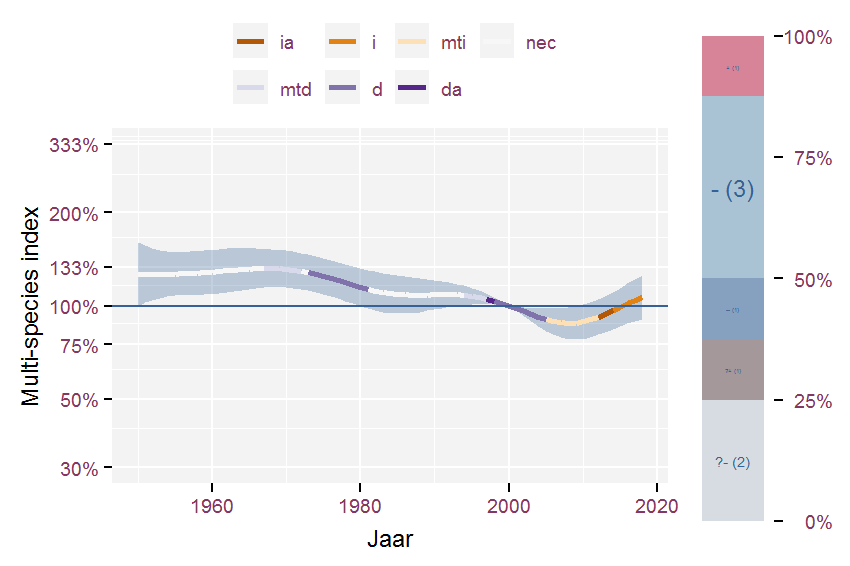
Figure 3.59: Multi-species index for species belonging to Socio-ecological groups (Stieperaere & Franssen 1982) moderately nutrient-poor, lime-poor, acidic peat bogs and period 1950-2018. The index uses 2000 as baseline year.
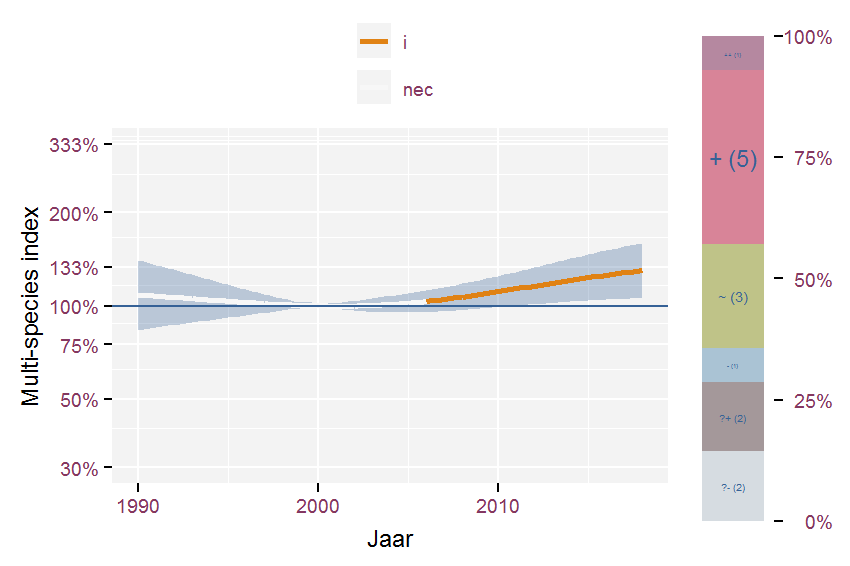
Figure 3.60: Multi-species index for species groups belonging to Socio-ecological groups (Stieperaere & Franssen 1982) moderately nutrient-poor, lime-poor, acidic peat bogs and period 1990-2018. The index uses 2000 as baseline year.
3.3.21 pioneer vegetation on open, nutrient (especially nitrogen) rich, wet soil
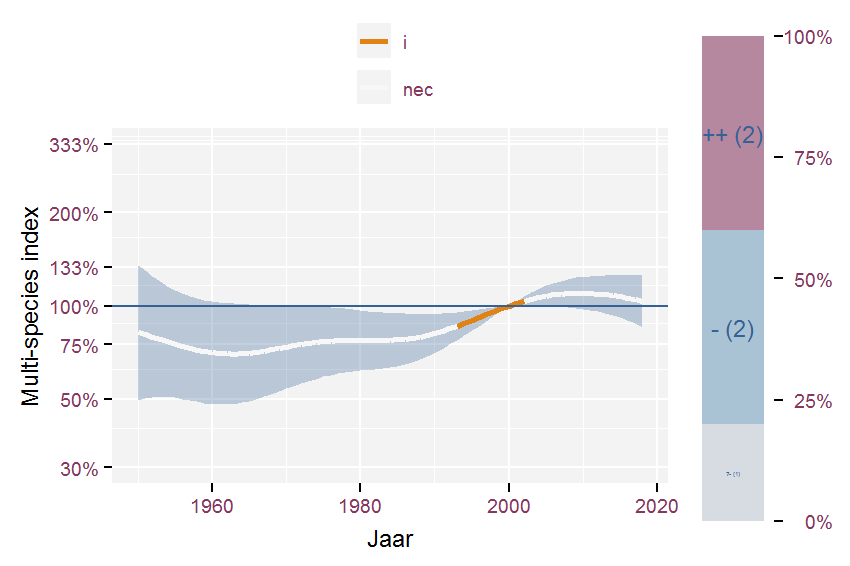
Figure 3.61: Multi-species index for species belonging to Socio-ecological groups (Stieperaere & Franssen 1982) pioneer vegetation on open, nutrient (especially nitrogen) rich, wet soil and period 1950-2018. The index uses 2000 as baseline year.
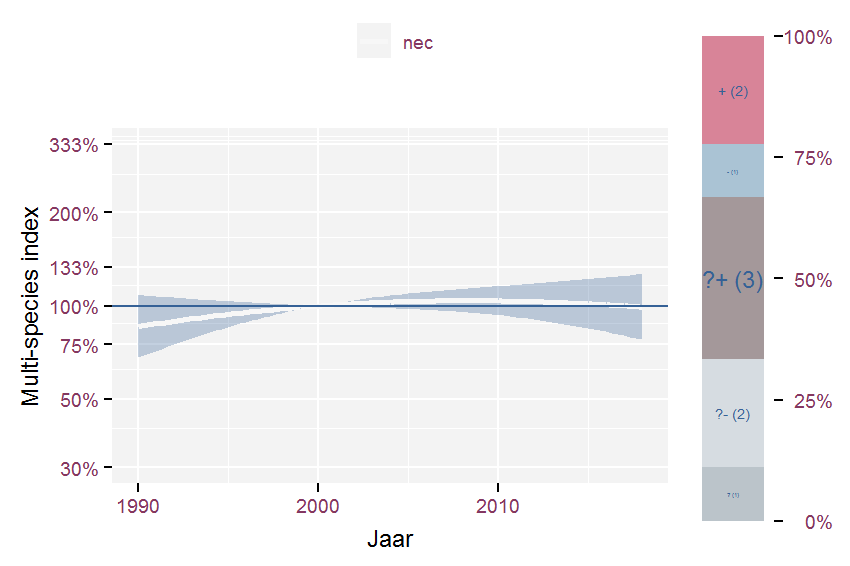
Figure 3.62: Multi-species index for species groups belonging to Socio-ecological groups (Stieperaere & Franssen 1982) pioneer vegetation on open, nutrient (especially nitrogen) rich, wet soil and period 1990-2018. The index uses 2000 as baseline year.
3.3.22 pioneer vegetation on relatively nutrient-rich places with varying water levels
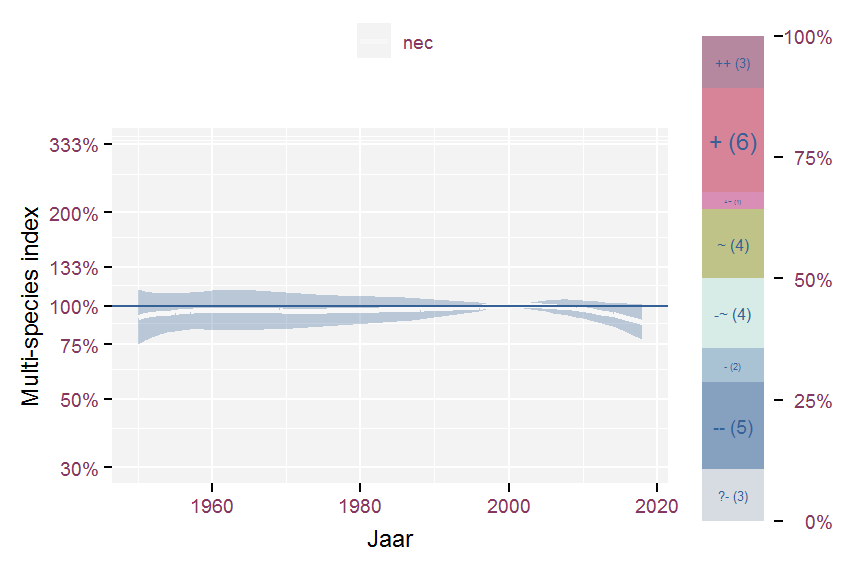
Figure 3.63: Multi-species index for species belonging to Socio-ecological groups (Stieperaere & Franssen 1982) pioneer vegetation on relatively nutrient-rich places with varying water levels and period 1950-2018. The index uses 2000 as baseline year.
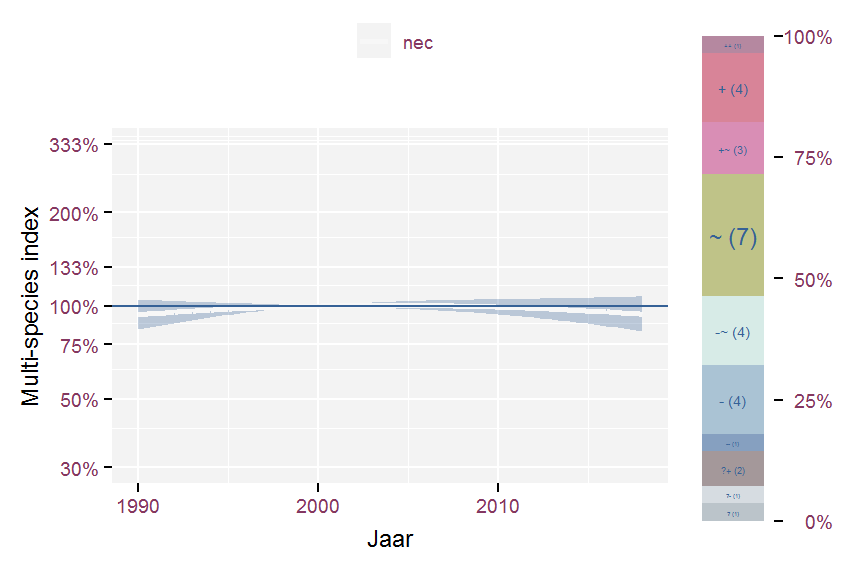
Figure 3.64: Multi-species index for species groups belonging to Socio-ecological groups (Stieperaere & Franssen 1982) pioneer vegetation on relatively nutrient-rich places with varying water levels and period 1990-2018. The index uses 2000 as baseline year.
3.3.23 raised bogs, wet heathlands and unfertilized grasslands on wet, very nutrient poor, peaty soils
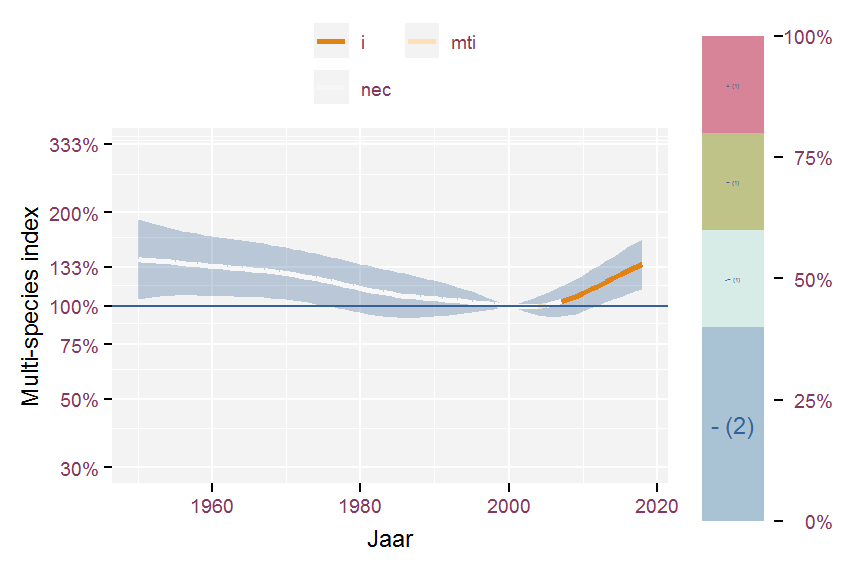
Figure 3.65: Multi-species index for species belonging to Socio-ecological groups (Stieperaere & Franssen 1982) raised bogs, wet heathlands and unfertilized grasslands on wet, very nutrient poor, peaty soils and period 1950-2018. The index uses 2000 as baseline year.
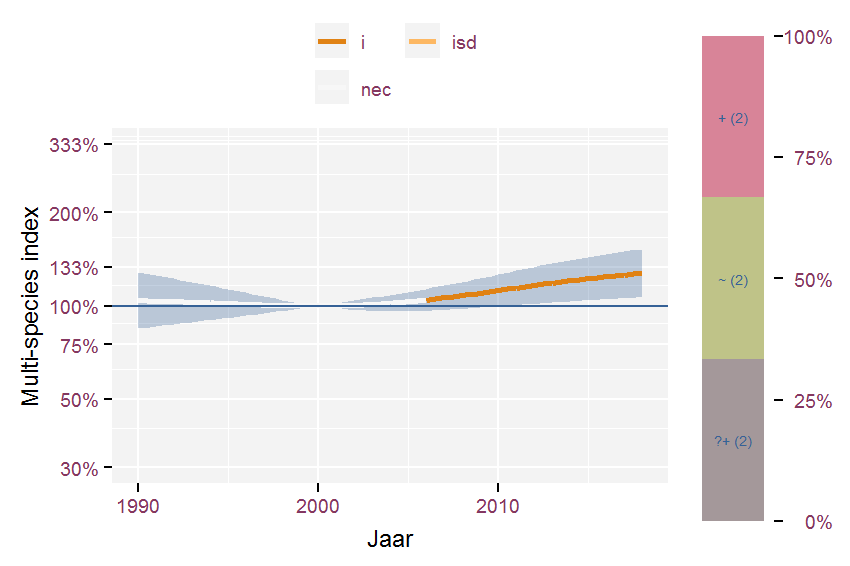
Figure 3.66: Multi-species index for species groups belonging to Socio-ecological groups (Stieperaere & Franssen 1982) raised bogs, wet heathlands and unfertilized grasslands on wet, very nutrient poor, peaty soils and period 1990-2018. The index uses 2000 as baseline year.
3.3.24 regularly trampled pioneer vegetation on nutrient-rich soil
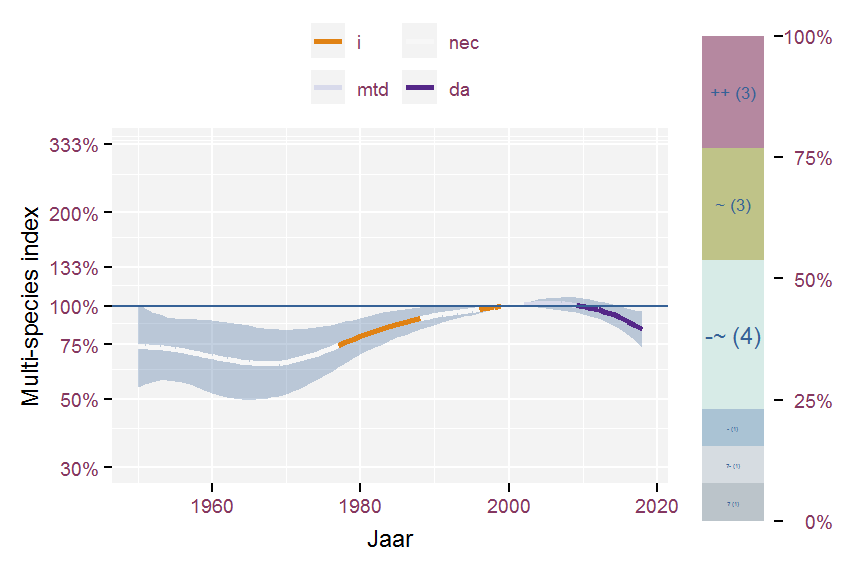
Figure 3.67: Multi-species index for species belonging to Socio-ecological groups (Stieperaere & Franssen 1982) regularly trampled pioneer vegetation on nutrient-rich soil and period 1950-2018. The index uses 2000 as baseline year.
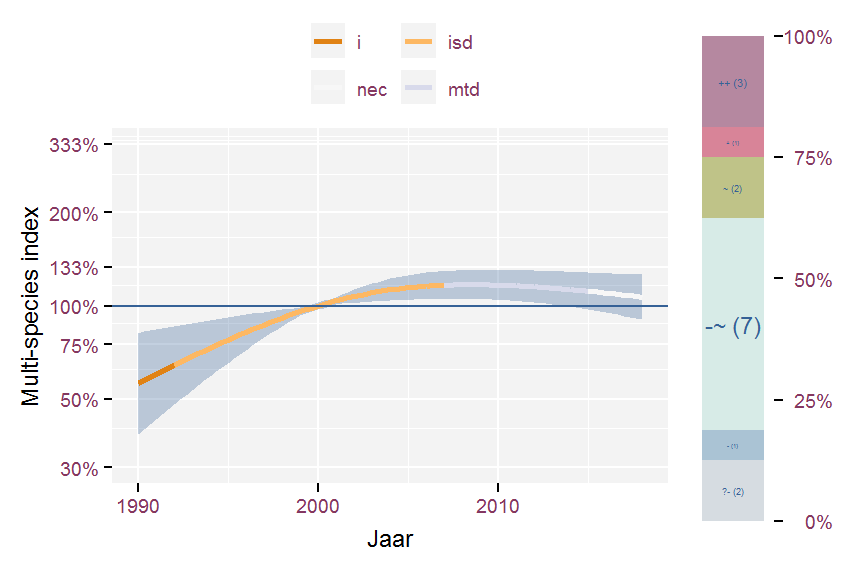
Figure 3.68: Multi-species index for species groups belonging to Socio-ecological groups (Stieperaere & Franssen 1982) regularly trampled pioneer vegetation on nutrient-rich soil and period 1990-2018. The index uses 2000 as baseline year.
3.3.25 rough herbaceous vegetation on little trampeld, nutrient-rich, rich, moderately dry soil

Figure 3.69: Multi-species index for species belonging to Socio-ecological groups (Stieperaere & Franssen 1982) rough herbaceous vegetation on little trampeld, nutrient-rich, rich, moderately dry soil and period 1950-2018. The index uses 2000 as baseline year.
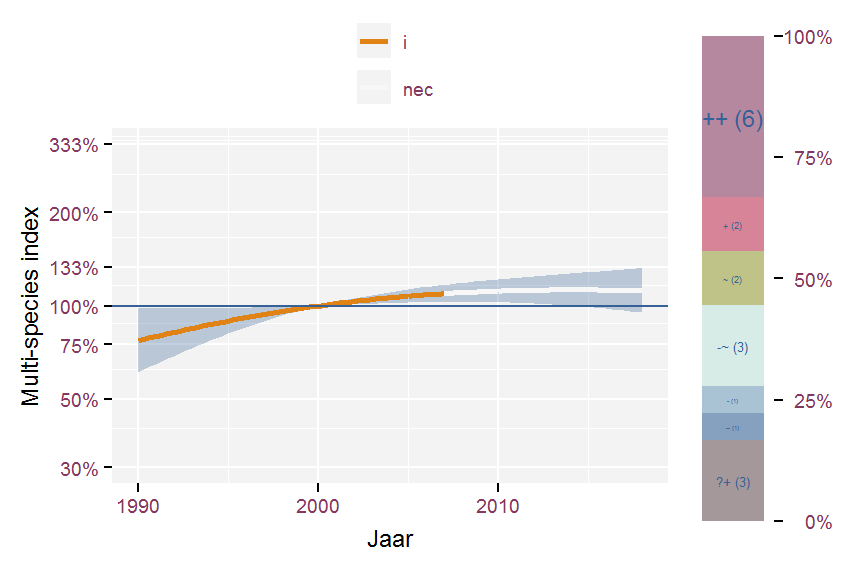
Figure 3.70: Multi-species index for species groups belonging to Socio-ecological groups (Stieperaere & Franssen 1982) rough herbaceous vegetation on little trampeld, nutrient-rich, rich, moderately dry soil and period 1990-2018. The index uses 2000 as baseline year.
3.3.26 rough herbaceous vegetation on little trampled calcareous, mineral, dry soil
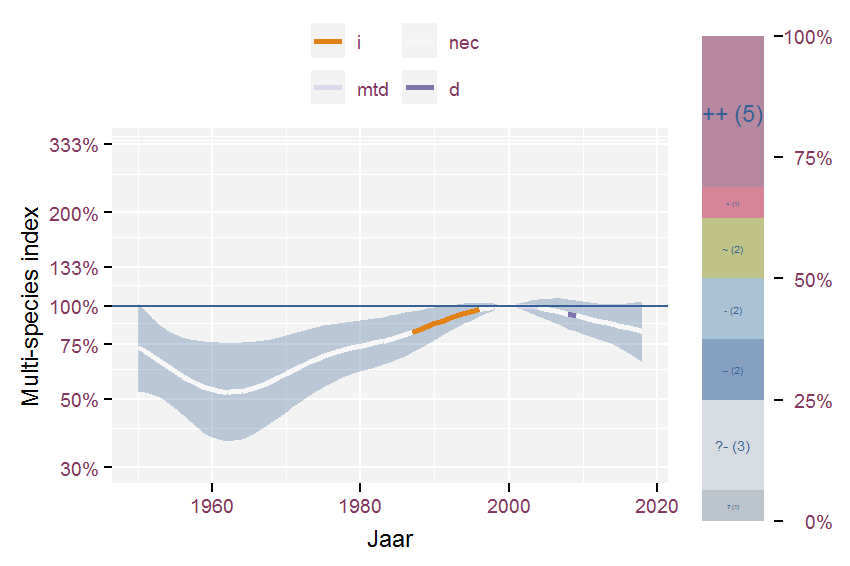
Figure 3.71: Multi-species index for species belonging to Socio-ecological groups (Stieperaere & Franssen 1982) rough herbaceous vegetation on little trampled calcareous, mineral, dry soil and period 1950-2018. The index uses 2000 as baseline year.
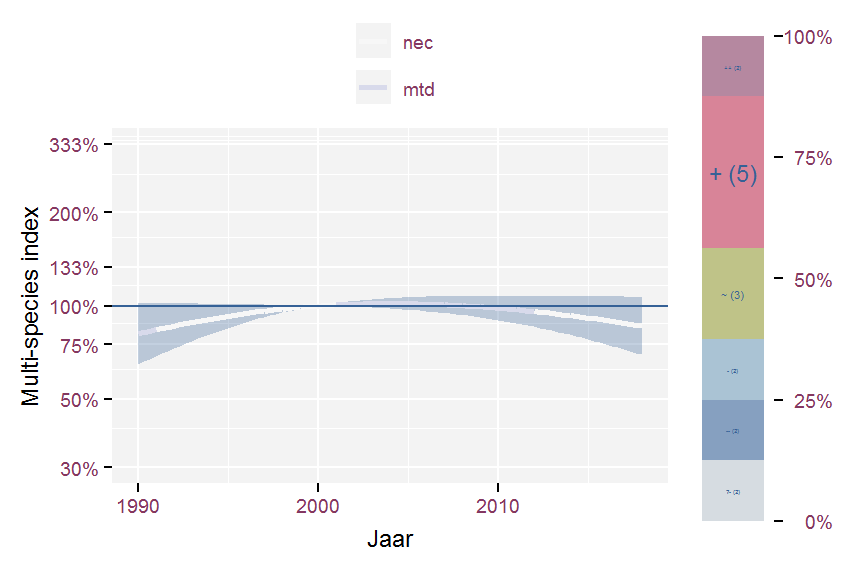
Figure 3.72: Multi-species index for species groups belonging to Socio-ecological groups (Stieperaere & Franssen 1982) rough herbaceous vegetation on little trampled calcareous, mineral, dry soil and period 1990-2018. The index uses 2000 as baseline year.
3.3.27 rough herbaceous vegetation on trampled, nutrient-rich, not humic, weakly calcareous, dry soil
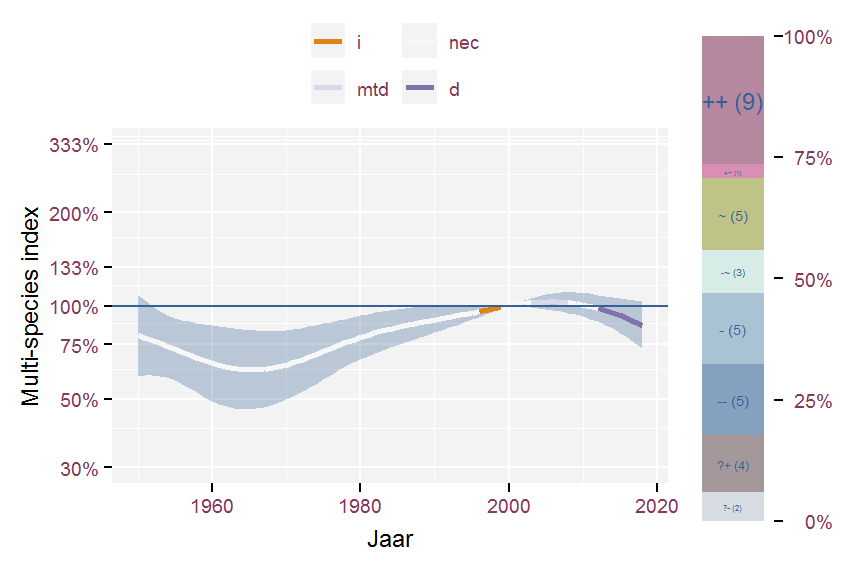
Figure 3.73: Multi-species index for species belonging to Socio-ecological groups (Stieperaere & Franssen 1982) rough herbaceous vegetation on trampled, nutrient-rich, not humic, weakly calcareous, dry soil and period 1950-2018. The index uses 2000 as baseline year.
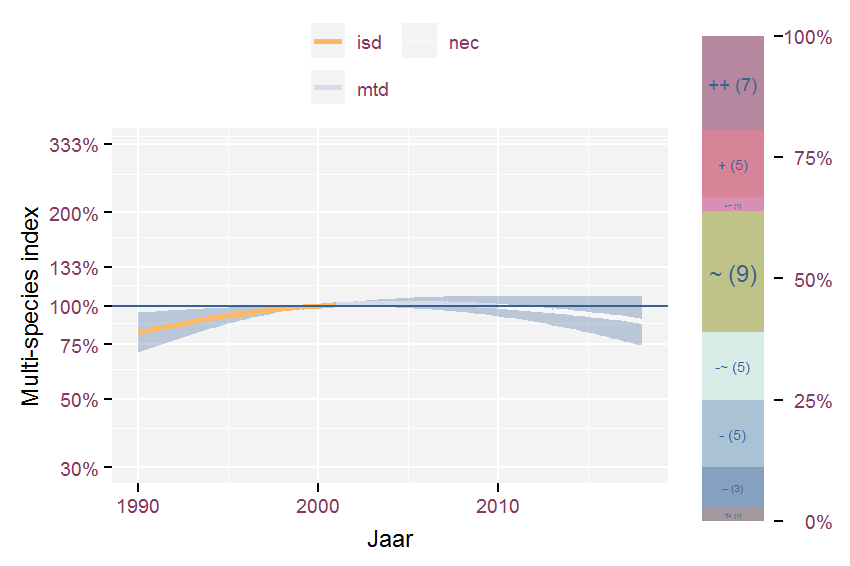
Figure 3.74: Multi-species index for species groups belonging to Socio-ecological groups (Stieperaere & Franssen 1982) rough herbaceous vegetation on trampled, nutrient-rich, not humic, weakly calcareous, dry soil and period 1990-2018. The index uses 2000 as baseline year.
3.3.28 shrub vegetation on moderately moist to dry, relatively nutrient-rich soil
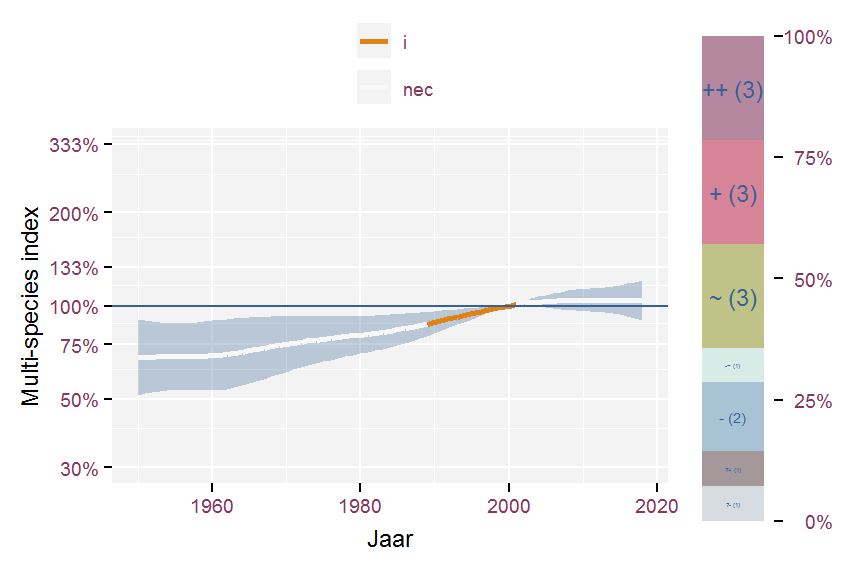
Figure 3.75: Multi-species index for species belonging to Socio-ecological groups (Stieperaere & Franssen 1982) shrub vegetation on moderately moist to dry, relatively nutrient-rich soil and period 1950-2018. The index uses 2000 as baseline year.
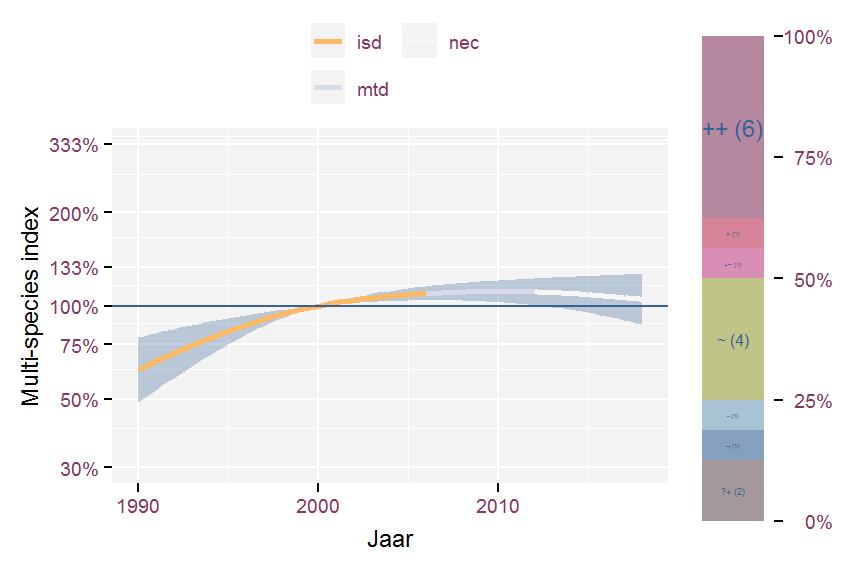
Figure 3.76: Multi-species index for species groups belonging to Socio-ecological groups (Stieperaere & Franssen 1982) shrub vegetation on moderately moist to dry, relatively nutrient-rich soil and period 1990-2018. The index uses 2000 as baseline year.
3.3.29 unfertilized grasslands on moist to wet nutrient-poor, weakly acidic soil
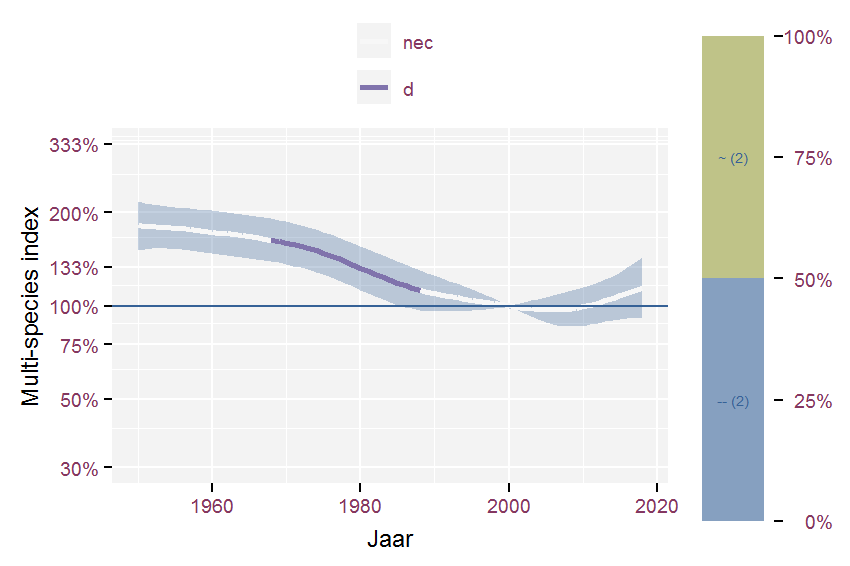
Figure 3.77: Multi-species index for species belonging to Socio-ecological groups (Stieperaere & Franssen 1982) unfertilized grasslands on moist to wet nutrient-poor, weakly acidic soil and period 1950-2018. The index uses 2000 as baseline year.
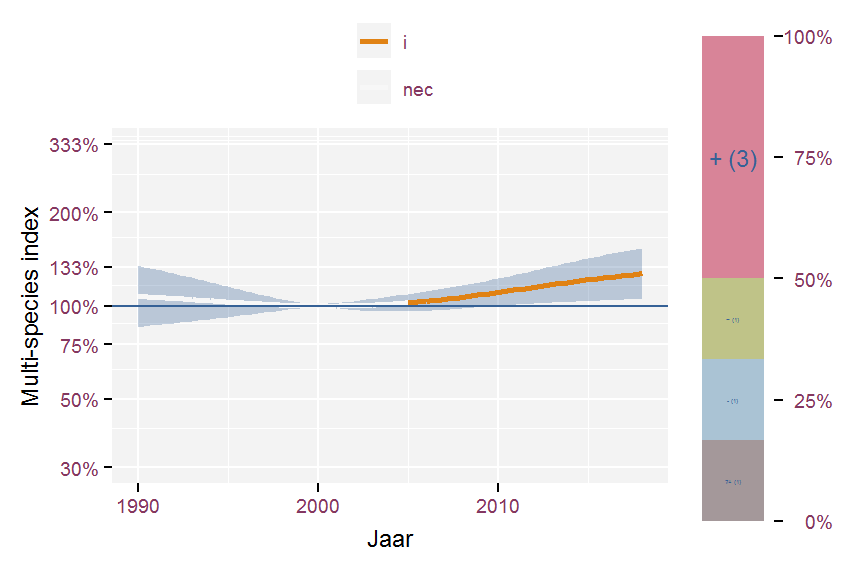
Figure 3.78: Multi-species index for species groups belonging to Socio-ecological groups (Stieperaere & Franssen 1982) unfertilized grasslands on moist to wet nutrient-poor, weakly acidic soil and period 1990-2018. The index uses 2000 as baseline year.
3.3.30 unfertilized Nardus grasslands on moderately moist to dry, nutrient-poor, acidic, humus-rich soil
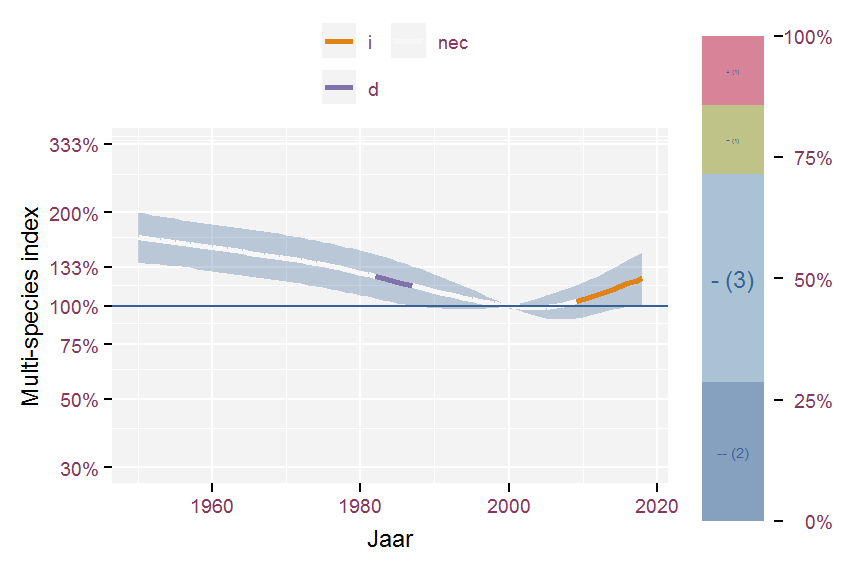
Figure 3.79: Multi-species index for species belonging to Socio-ecological groups (Stieperaere & Franssen 1982) unfertilized Nardus grasslands on moderately moist to dry, nutrient-poor, acidic, humus-rich soil and period 1950-2018. The index uses 2000 as baseline year.
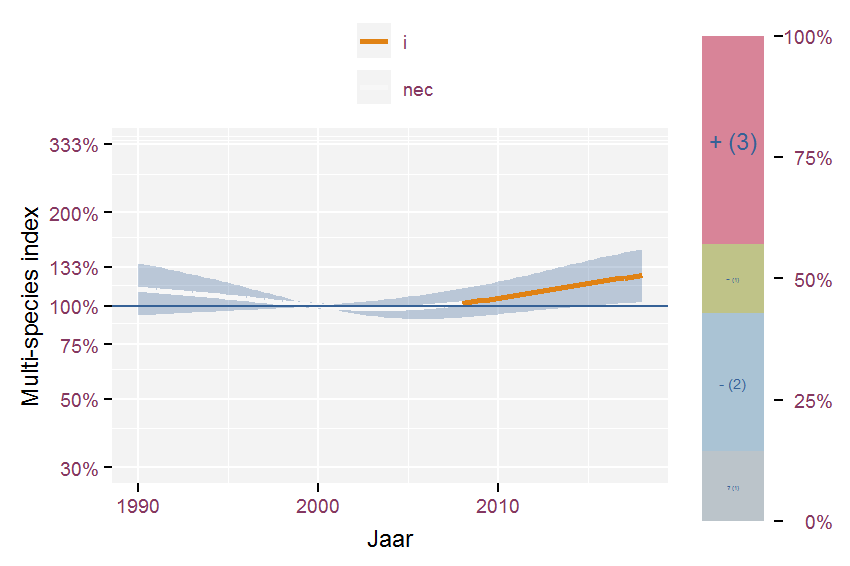
Figure 3.80: Multi-species index for species groups belonging to Socio-ecological groups (Stieperaere & Franssen 1982) unfertilized Nardus grasslands on moderately moist to dry, nutrient-poor, acidic, humus-rich soil and period 1990-2018. The index uses 2000 as baseline year.
3.3.31 walls and rocks
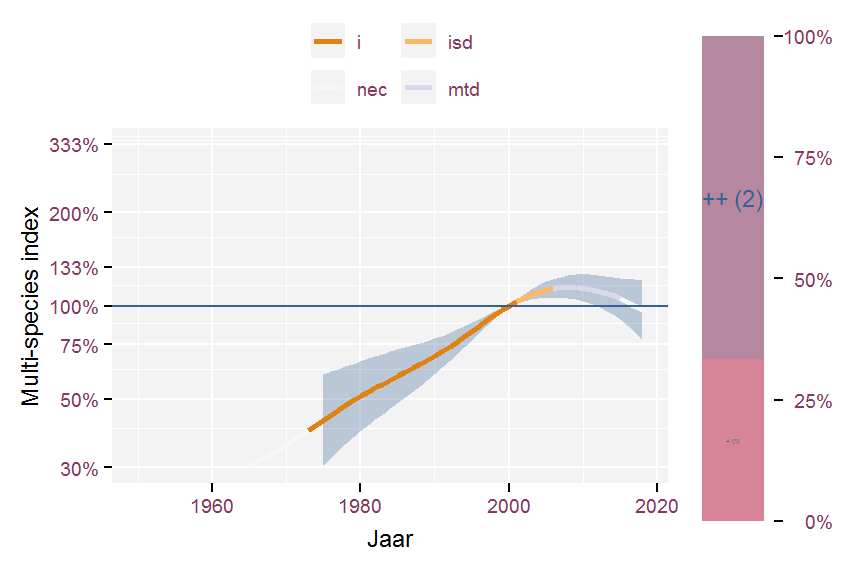
Figure 3.81: Multi-species index for species belonging to Socio-ecological groups (Stieperaere & Franssen 1982) walls and rocks and period 1950-2018. The index uses 2000 as baseline year.
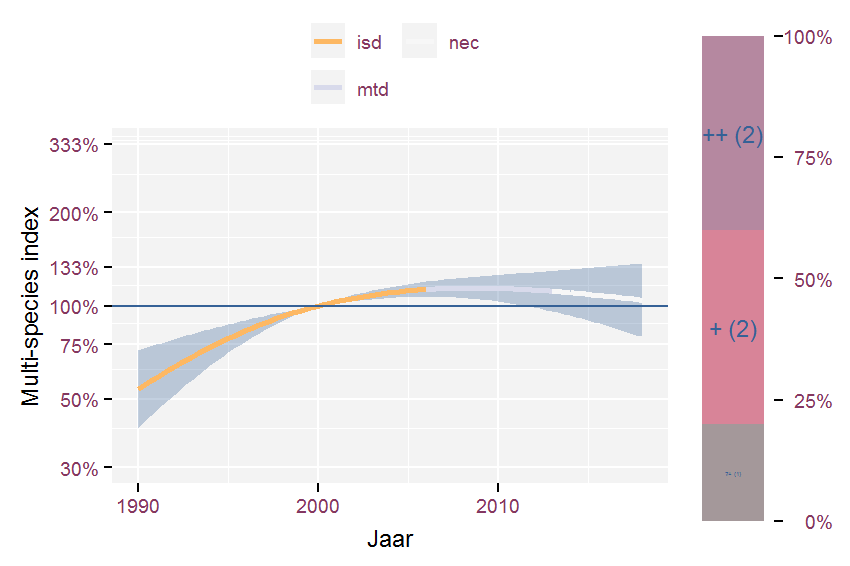
Figure 3.82: Multi-species index for species groups belonging to Socio-ecological groups (Stieperaere & Franssen 1982) walls and rocks and period 1990-2018. The index uses 2000 as baseline year.
3.3.32 young forest plantations and forest verges on nutrient rich, neutral, humic moderately moist to dry soil
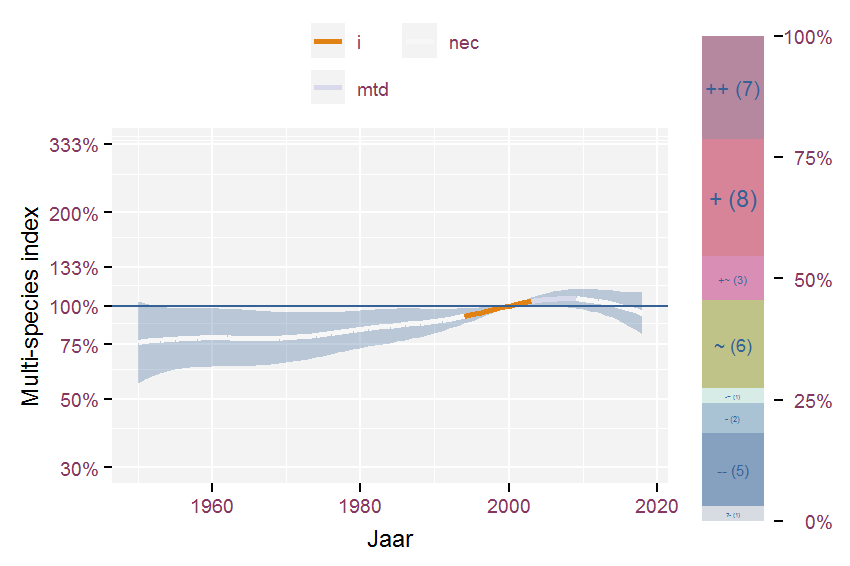
Figure 3.83: Multi-species index for species belonging to Socio-ecological groups (Stieperaere & Franssen 1982) young forest plantations and forest verges on nutrient rich, neutral, humic moderately moist to dry soil and period 1950-2018. The index uses 2000 as baseline year.
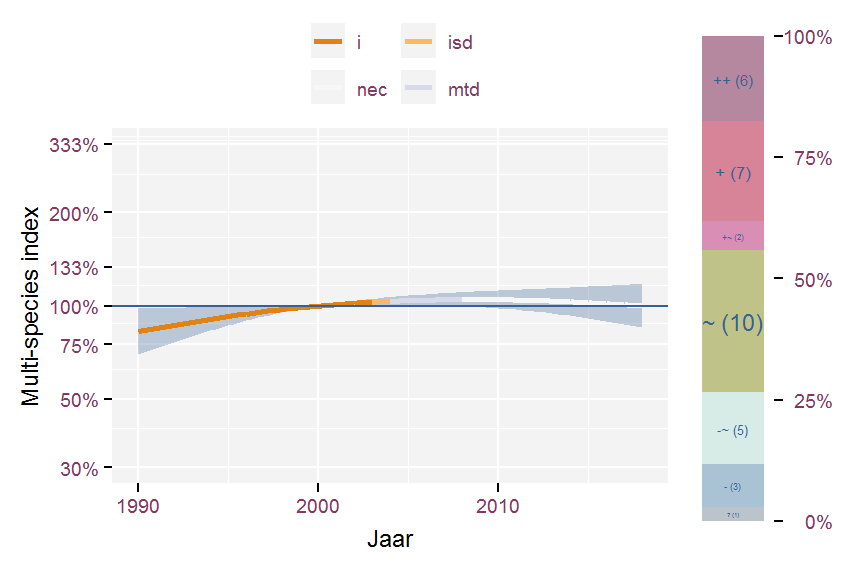
Figure 3.84: Multi-species index for species groups belonging to Socio-ecological groups (Stieperaere & Franssen 1982) young forest plantations and forest verges on nutrient rich, neutral, humic moderately moist to dry soil and period 1990-2018. The index uses 2000 as baseline year.
3.4 Attributes indicating environmental conditions
3.4.1 nutrient availabity (Runhaar et al. 2004)
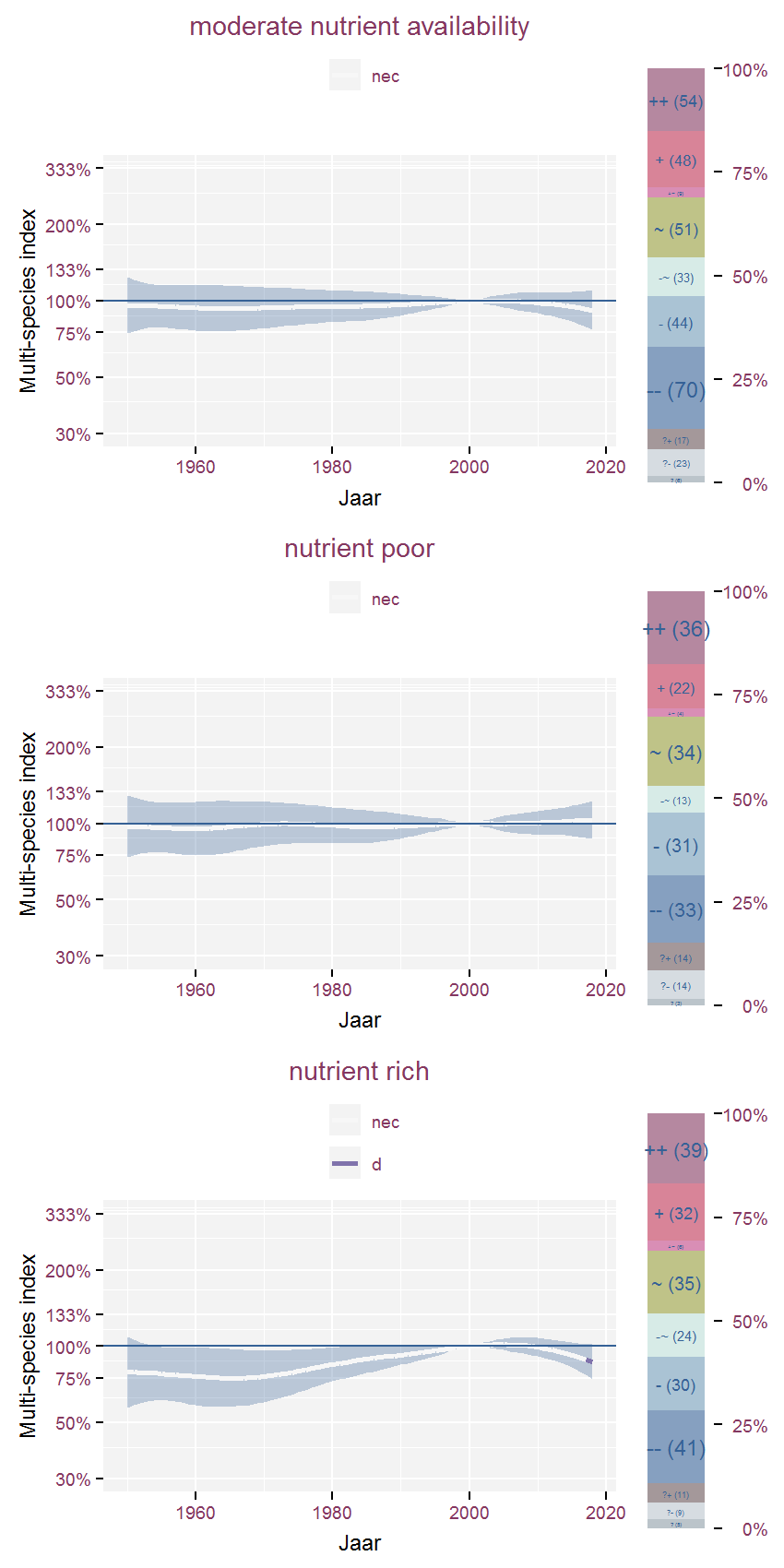
Figure 3.85: Multi-species index for species groups determined by nutrient availabity (Runhaar et al. 2004) and period 1950-2018. The index uses 2000 as baseline year.
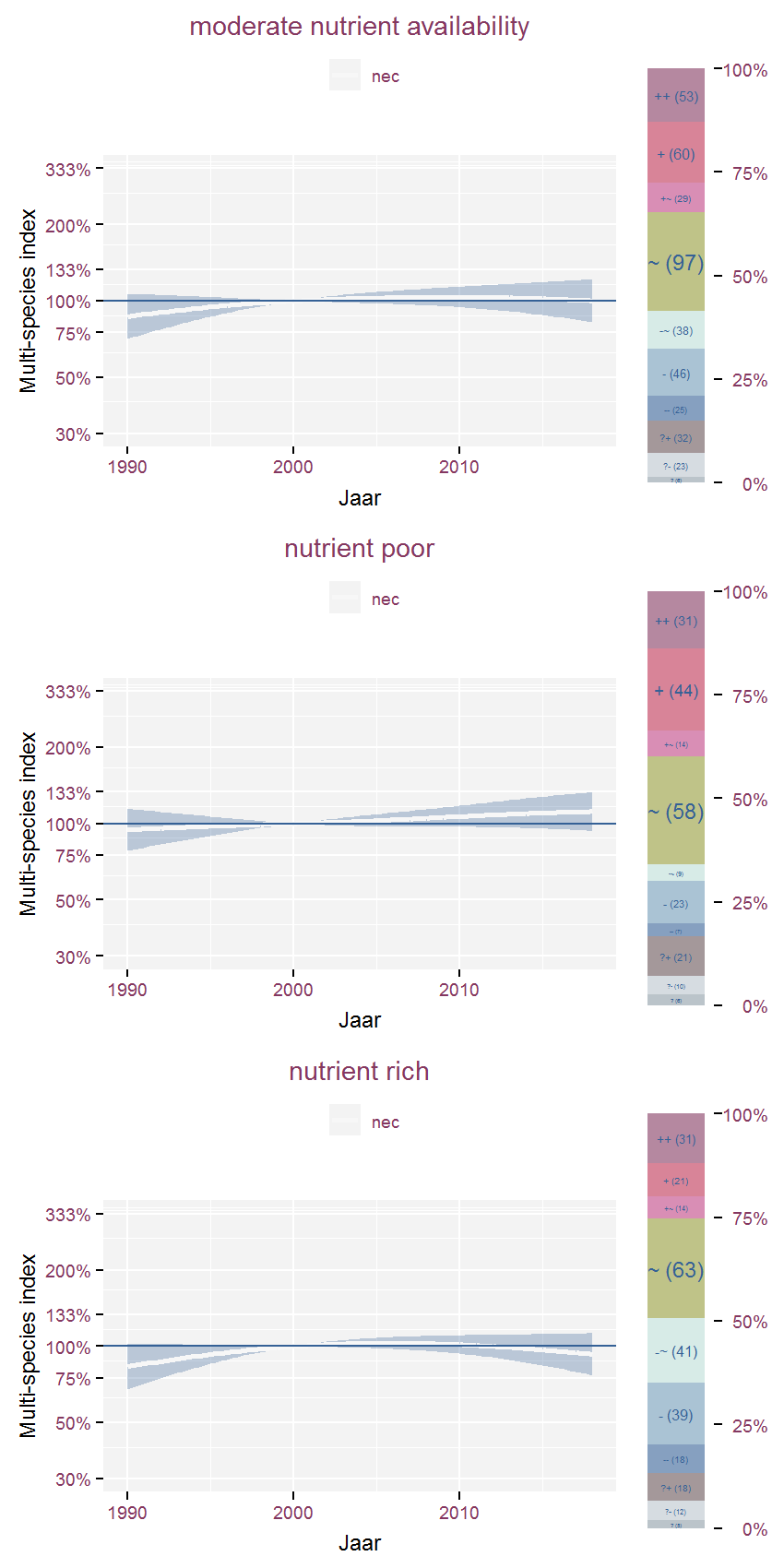
Figure 3.86: Multi-species index for species groups determined by nutrient availabity (Runhaar et al. 2004) and period 1990-2018. The index uses 2000 as baseline year.
3.4.2 Ellenberg nitrogen value (regrouped)
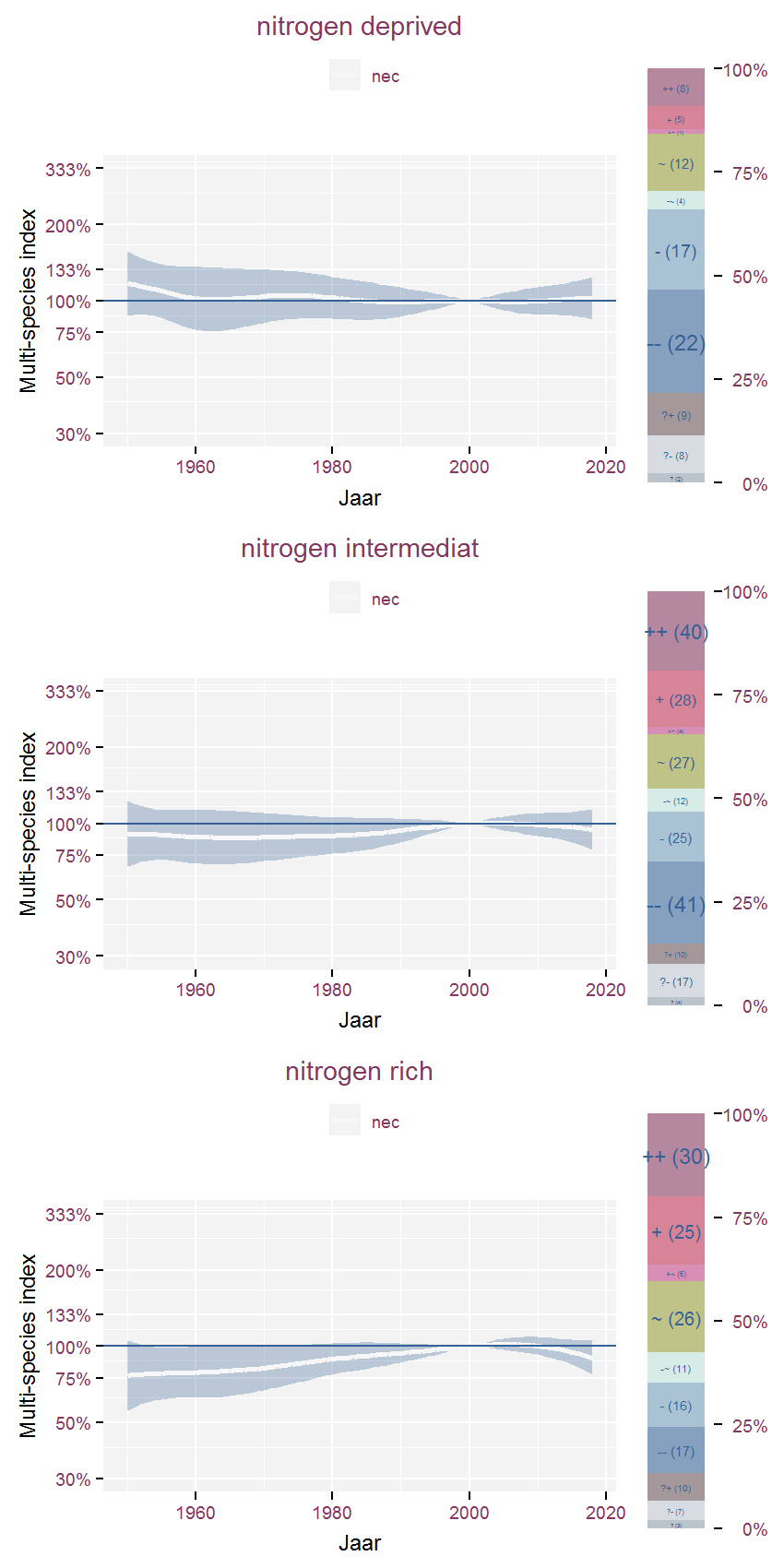
Figure 3.87: Multi-species index for species groups determined by Ellenberg nitrogen value (regrouped) and period 1950-2018. The index uses 2000 as baseline year.
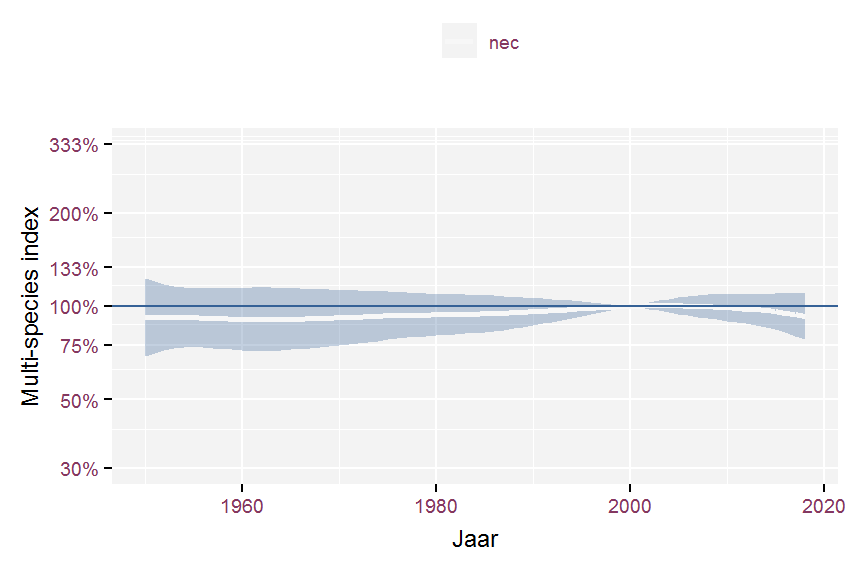
Figure 3.88: Multi-species index for Ellenberg nitrogen value (regrouped) and period 1950-2018. The index uses 2000 as baseline year and Ellenberg ordinal values as weights.
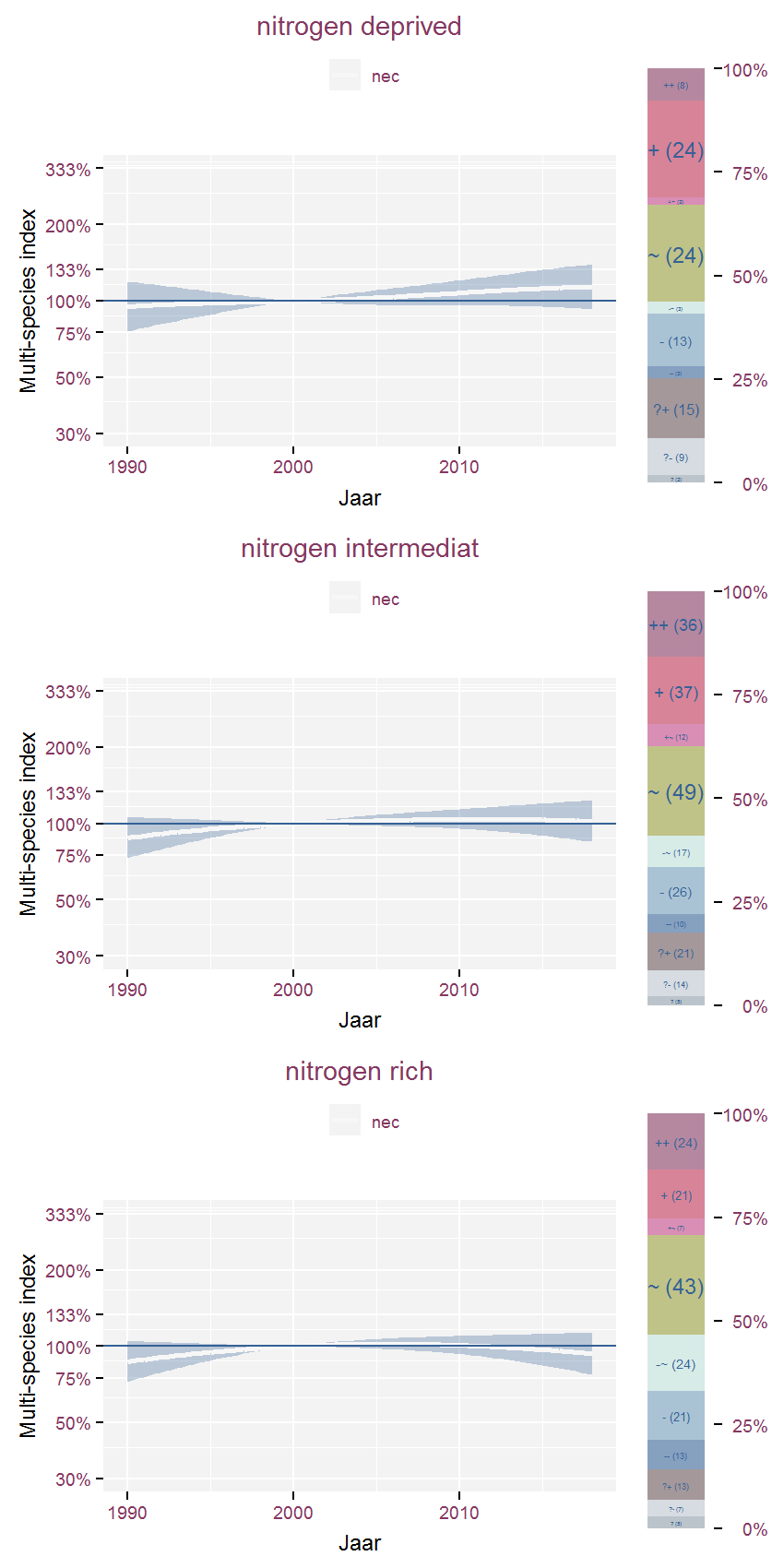
Figure 3.89: Multi-species index for species groups determined by Ellenberg nitrogen value (regrouped) and period 1990-2018. The index uses 2000 as baseline year.
-1.png)
Figure 3.90: )Multi-species index for Ellenberg nitrogen value (regrouped) and period 1990-2018. The index uses 2000 as baseline year and Ellenberg ordinal values as weights.
3.4.3 Ellenberg reaction value (regrouped)
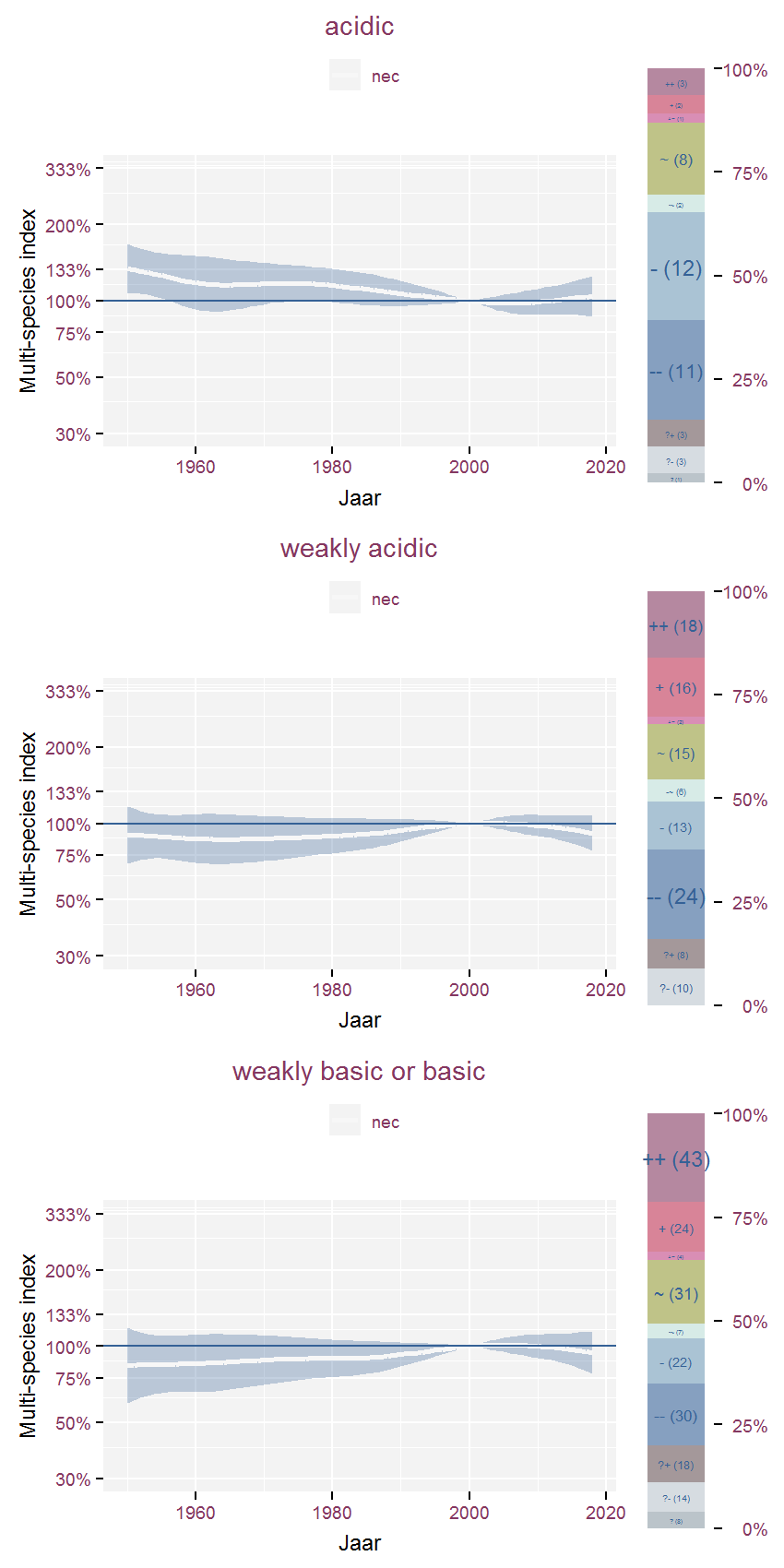
Figure 3.91: Multi-species index for species groups determined by Ellenberg reaction value (regrouped) and period 1950-2018. The index uses 2000 as baseline year.

Figure 3.92: Multi-species index for Ellenberg reaction value (regrouped) and period 1950-2018. The index uses 2000 as baseline year and Ellenberg ordinal values as weights.
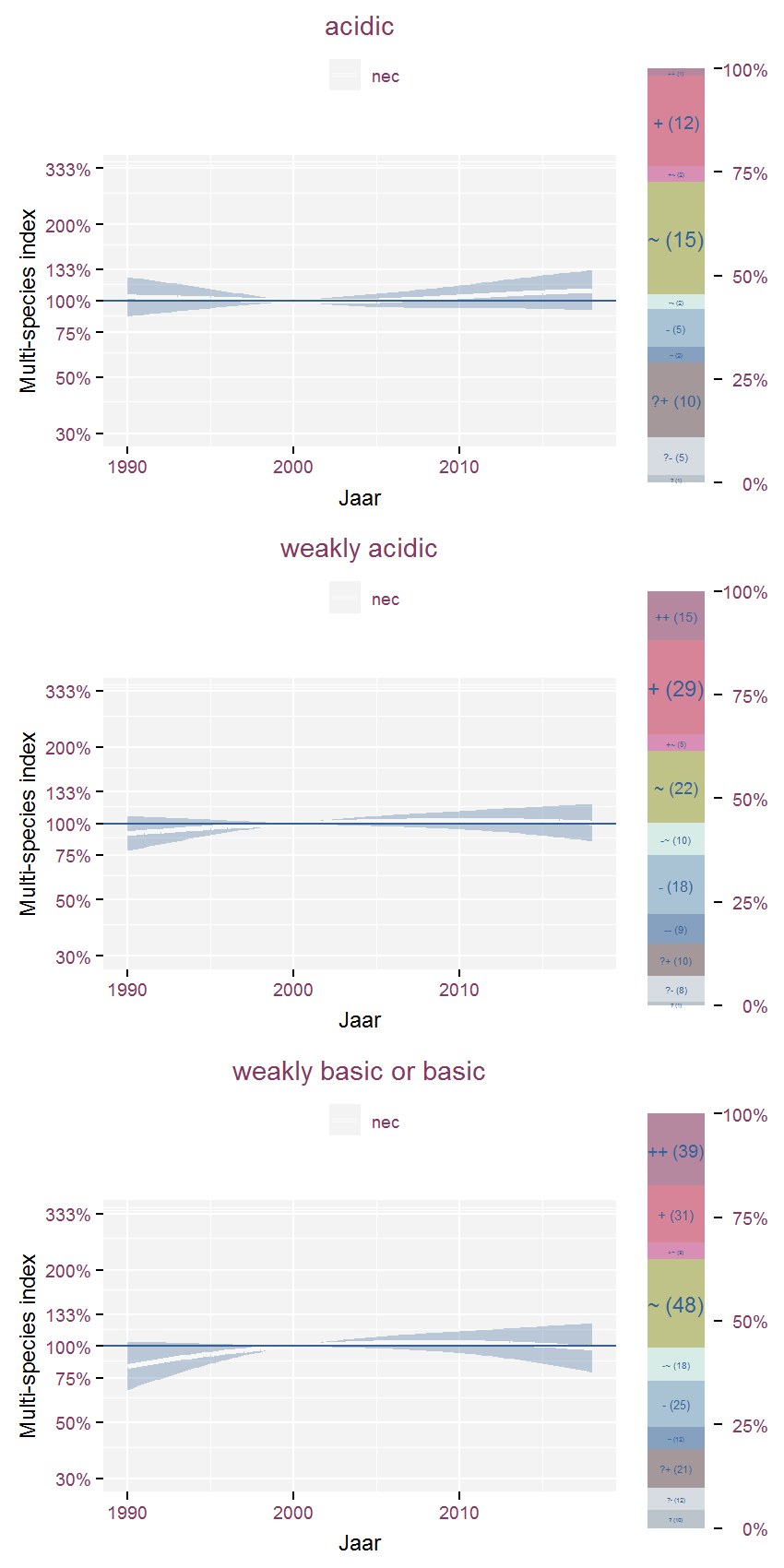
Figure 3.93: Multi-species index for species groups determined by Ellenberg reaction value (regrouped) and period 1990-2018. The index uses 2000 as baseline year.
-1.png)
Figure 3.94: )Multi-species index for Ellenberg reaction value (regrouped) and period 1990-2018. The index uses 2000 as baseline year and Ellenberg ordinal values as weights.
3.4.4 Ellenberg temperature value (regrouped)

Figure 3.95: Multi-species index for species groups determined by Ellenberg temperature value (regrouped) and period 1950-2018. The index uses 2000 as baseline year.
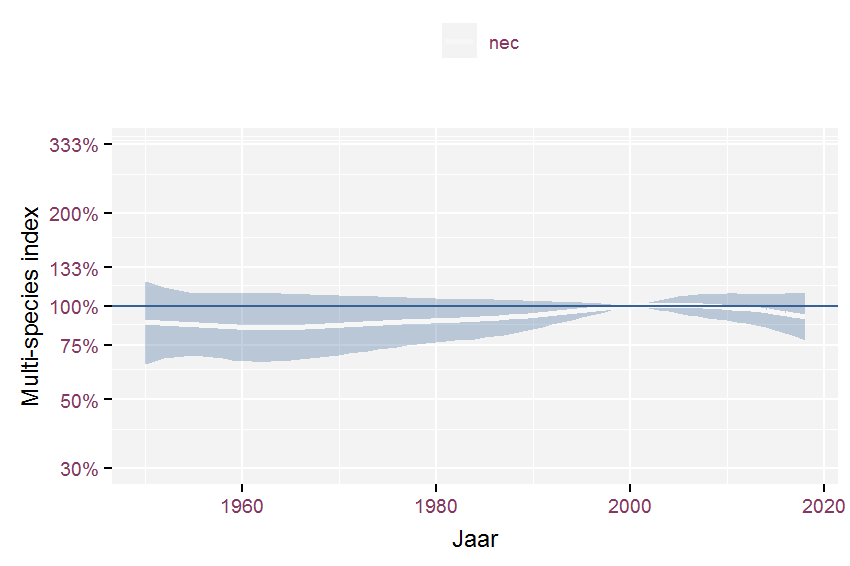
Figure 3.96: Multi-species index for Ellenberg temperature value (regrouped) and period 1950-2018. The index uses 2000 as baseline year and Ellenberg ordinal values as weights.
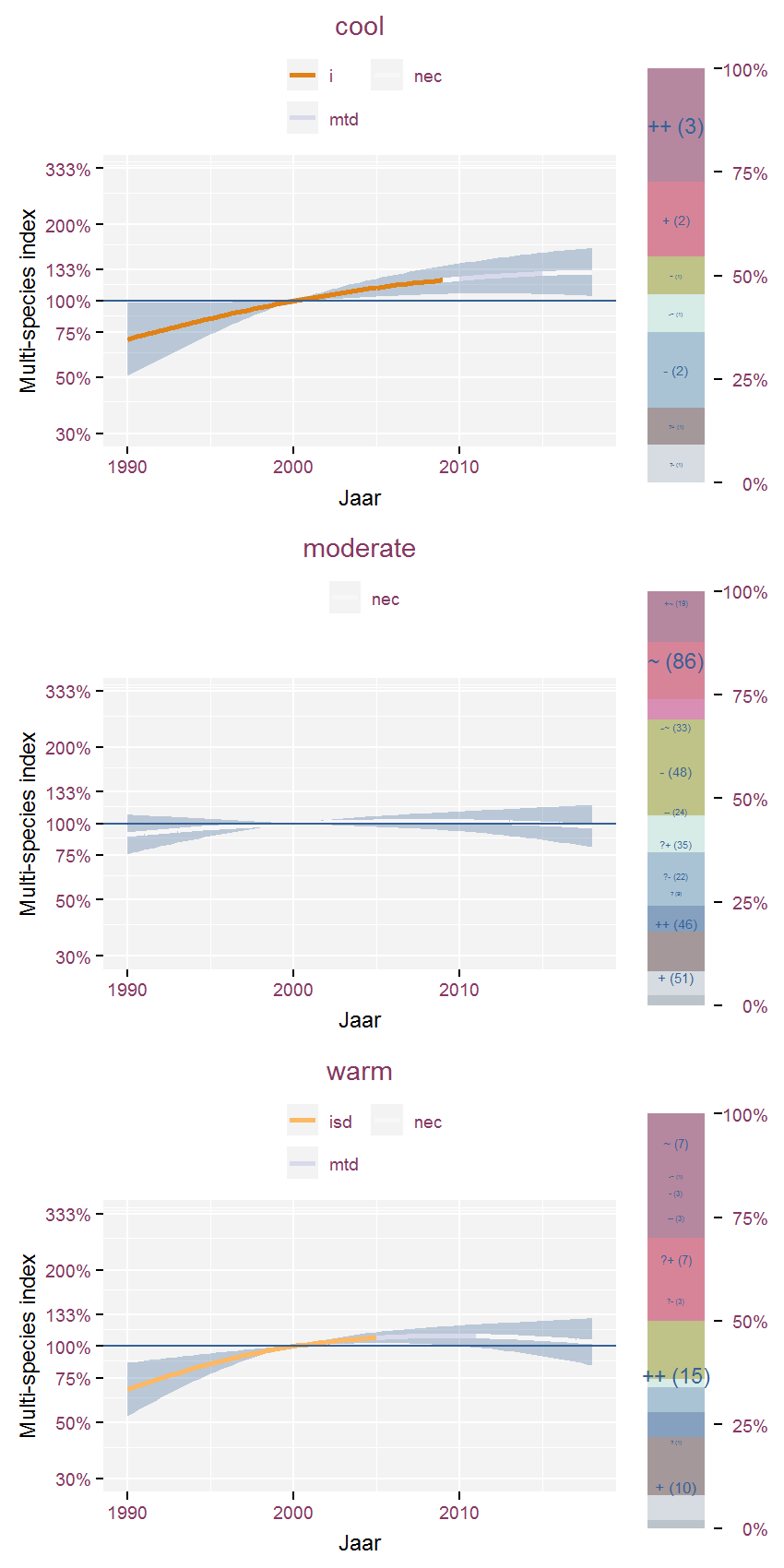
Figure 3.97: Multi-species index for species groups determined by Ellenberg temperature value (regrouped) and period 1990-2018. The index uses 2000 as baseline year.
-1.png)
Figure 3.98: )Multi-species index for Ellenberg temperature value (regrouped) and period 1990-2018. The index uses 2000 as baseline year and Ellenberg ordinal values as weights.
3.4.5 Ellenberg humidity value (regrouped)

Figure 3.99: Multi-species index for species groups determined by Ellenberg humidity value (regrouped) and period 1950-2018. The index uses 2000 as baseline year.
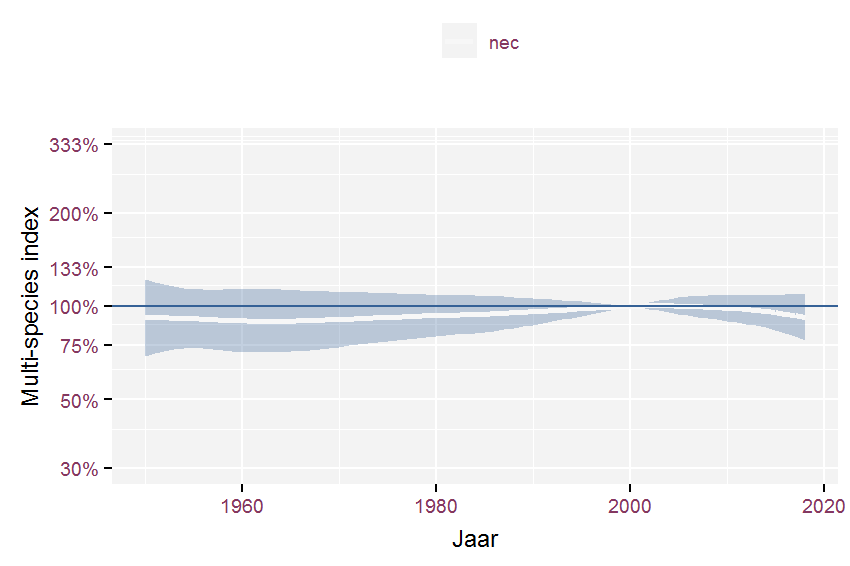
Figure 3.100: Multi-species index for Ellenberg humidity value (regrouped) and period 1950-2018. The index uses 2000 as baseline year and Ellenberg ordinal values as weights.

Figure 3.101: Multi-species index for species groups determined by Ellenberg humidity value (regrouped) and period 1990-2018. The index uses 2000 as baseline year.
-1.png)
Figure 3.102: )Multi-species index for Ellenberg humidity value (regrouped) and period 1990-2018. The index uses 2000 as baseline year and Ellenberg ordinal values as weights.
3.4.6 substrate (Runhaar et al. 2004)
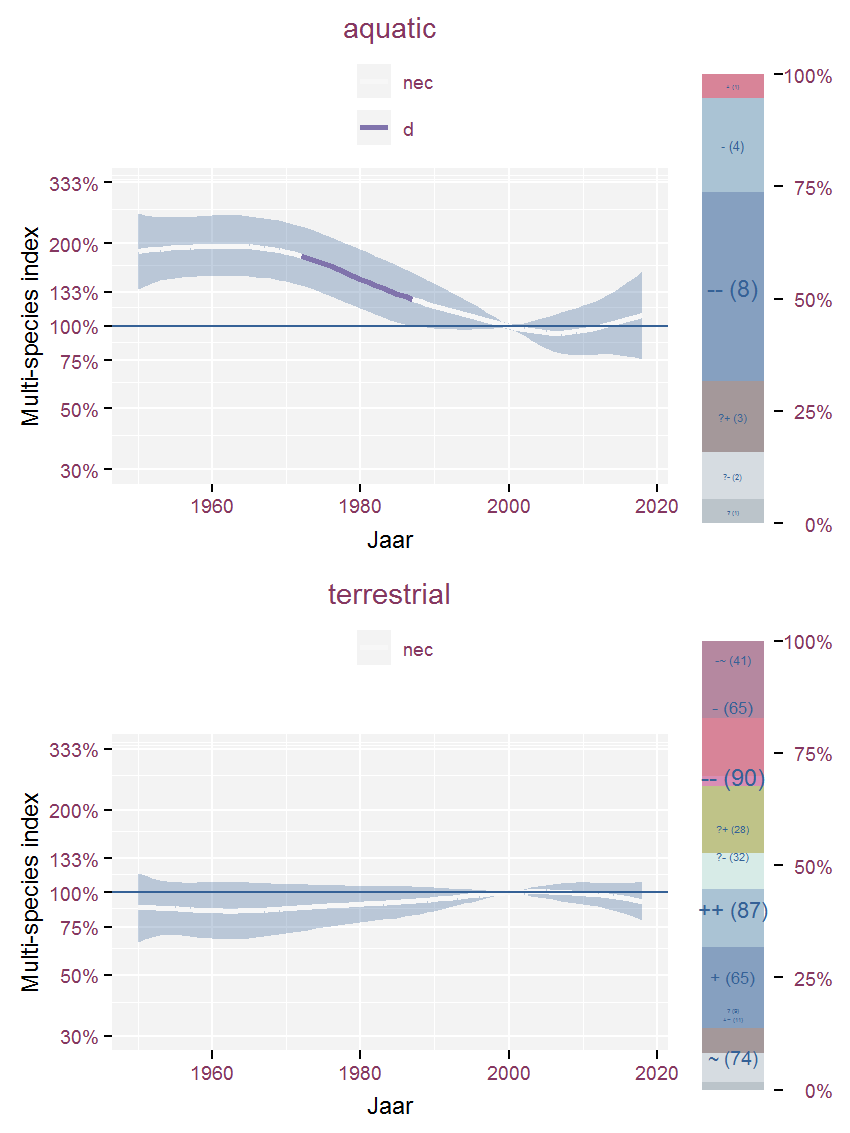
Figure 3.103: Multi-species index for species groups determined by substrate (Runhaar et al. 2004) and period 1950-2018. The index uses 2000 as baseline year.

Figure 3.104: Multi-species index for species groups determined by substrate (Runhaar et al. 2004) and period 1990-2018. The index uses 2000 as baseline year.
3.4.7 CSR ordinate values
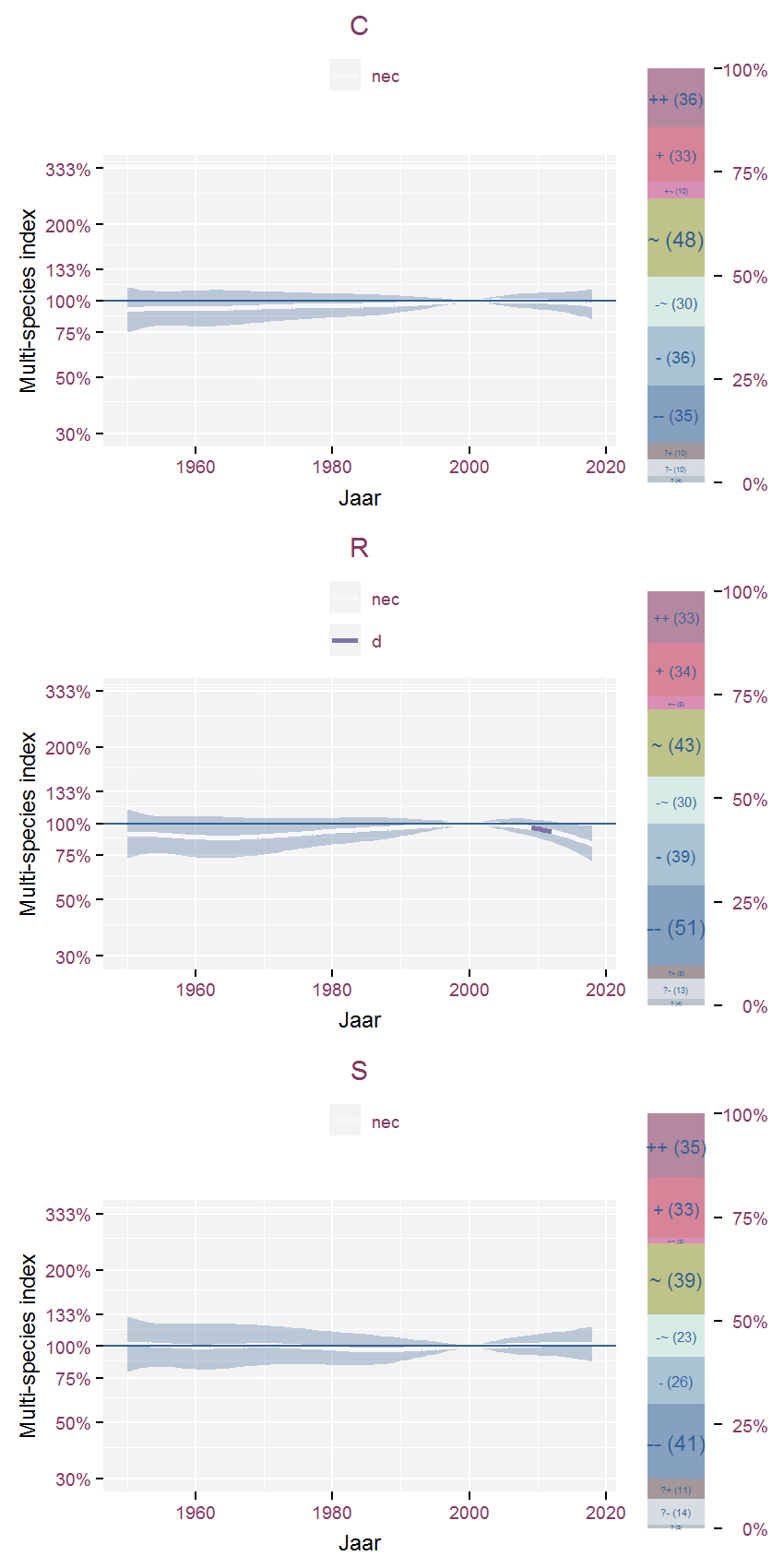
Figure 3.105: Multi-species index for species groups determined by CSR ordinate values and period 1950-2018. The index uses 2000 as baseline year.
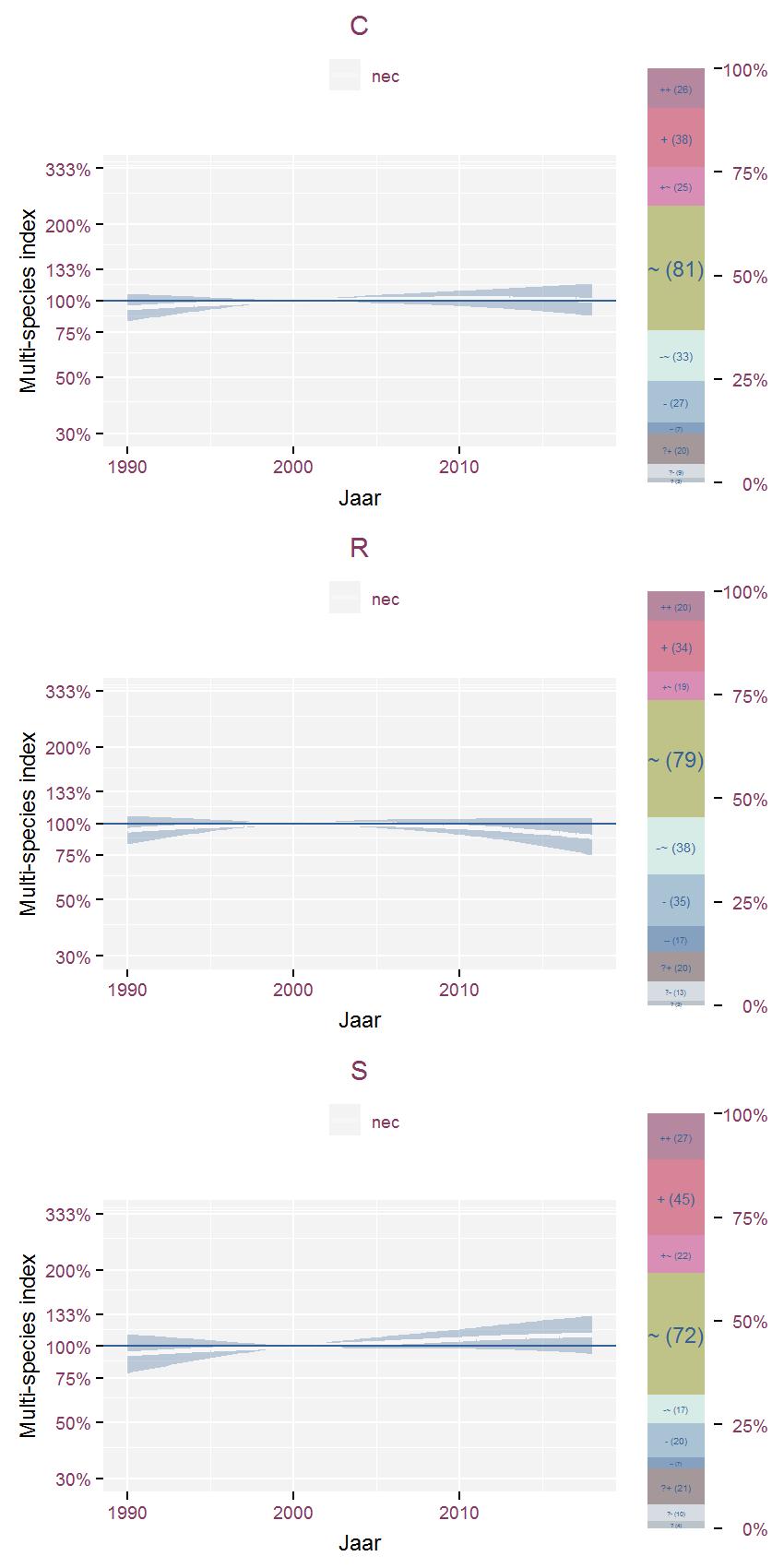
Figure 3.106: Multi-species index for species groups determined by CSR ordinate values and period 1990-2018. The index uses 2000 as baseline year.
3.5 Other species attributes
3.5.1 chromosome polyploidy
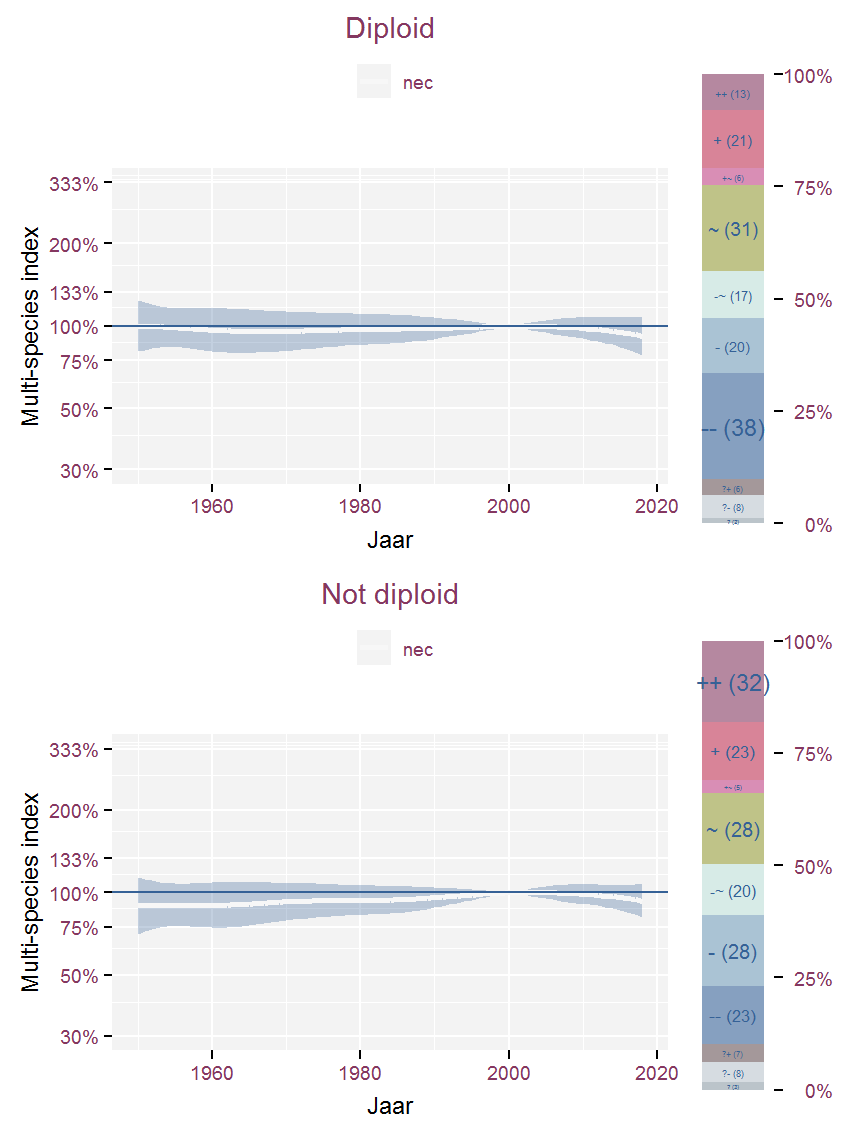
Figure 3.107: Multi-species index for species groups determined by chromosome polyploidy and period 1950-2018. The index uses 2000 as baseline year.
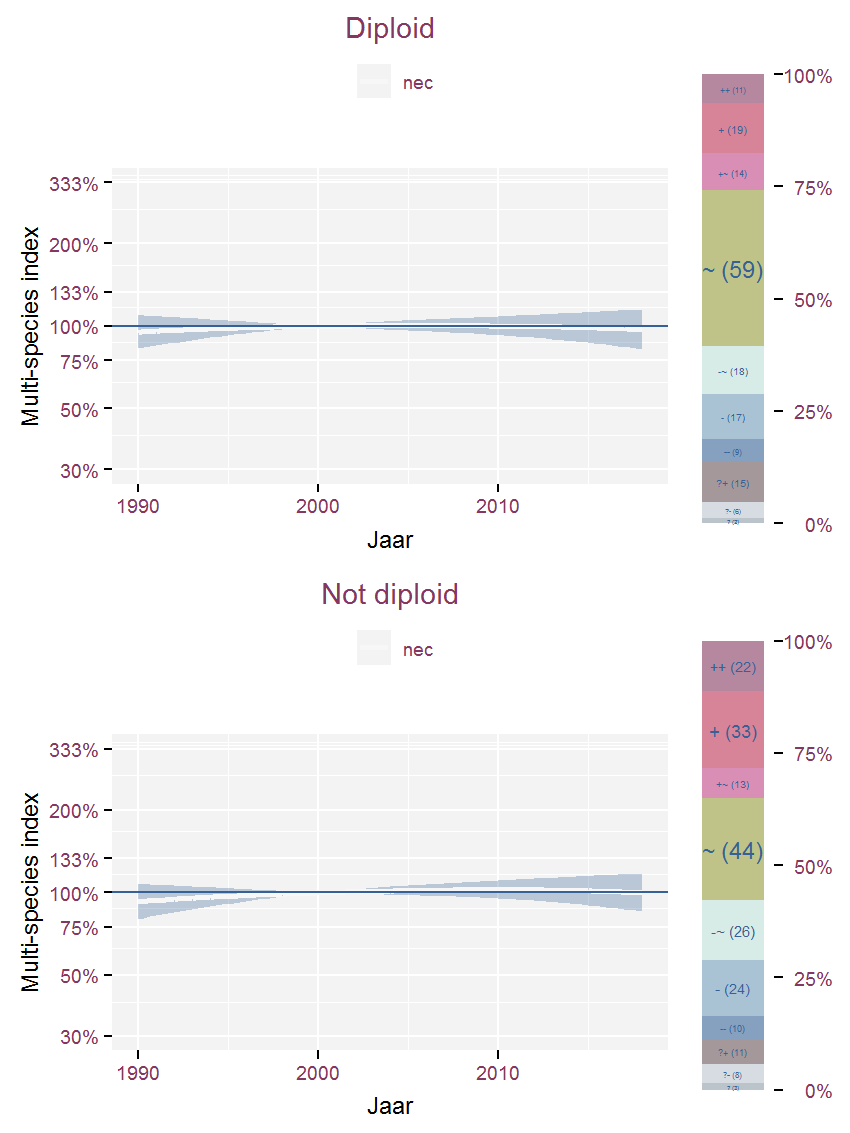
Figure 3.108: Multi-species index for species groups determined by chromosome polyploidy and period 1990-2018. The index uses 2000 as baseline year.
3.5.2 ecological amplitude

Figure 3.109: Multi-species index for species groups determined by ecological amplitude and period 1950-2018. The index uses 2000 as baseline year.

Figure 3.110: Multi-species index for species groups determined by ecological amplitude and period 1990-2018. The index uses 2000 as baseline year.
3.5.3 indigenous, archeophyte or neophyte

Figure 3.111: Multi-species index for species groups determined by indigenous, archeophyte or neophyte and period 1950-2018. The index uses 2000 as baseline year.

Figure 3.112: Multi-species index for species groups determined by indigenous, archeophyte or neophyte and period 1990-2018. The index uses 2000 as baseline year.